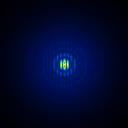 | 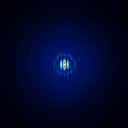 | 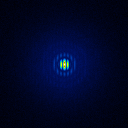 |
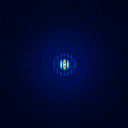 | 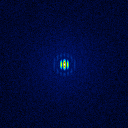 | 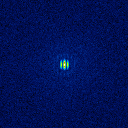 |
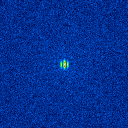 | 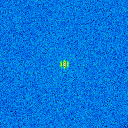 | 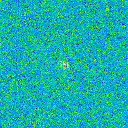 |
This simulation should give an answer to the question how the quality of the reconstruction depends on the magnitude of a calibrator. The difficulties arising from a non constant sky background due to an object halo, or an imperfect AO are ignored. The setup used for this experiment is (for the common test setup see table 1):
This experiment uses monochromatic PSFs for the J- and K-Band with a strehl of 0.3. In contrast to all other simulations the calibrator and target uses the same PSF. Therefore only the brightness of the target and calibrator has an influence on the deconvolution. The setup for the PSF generation is described in table 1.
| Parameter | Description |
|---|---|
| Atmosphere/AO | The AO delivers a strehl of about 30 percent. |
| Observation | In order to test the sensitivity to the calibrator brightness, magnitudes from 14mag to 22 mag in 1mag steps are used. |
The experiment uses a target which consists of a scaled down image of NGC4151 and an overlayed image of a simulated dust torus. A second object shows a small star cluster where different distances and brightness levels do exist. These objects are observed (we assume this) in J-Band and K-band five times at different position angles. The image contains exactly one star which can be used as a calibrator. It was additionally assumed, that the background around this star could be perfectly compensated (no inhomogenious sky background or target halo).
The raw data were generated according to the common scheme described in section Overview. In addition, the images for the target and calibrator are generated separately which means, that the psf-star image is not influenced by the target (no halo, etc.).
All simulated input data for the LN DRS pipeline are available as tar-files (ex1_j_input.tar.gz (16MB) and ex1_k_input.tar.gz (18MB)). The corresponding results are also available as tar files (ex1_j_results.tar.gz (4.8MB) and ex1_k_results.tar.gz (5.2MB)).
The generated calibrator raw images are shown in section Calibrator. The raw images and deconvolution results are shown in section Raw Frames and Results for an AGN for the AGN and section Raw Frames and Results for a Star Cluster for the star cluster.
The simulated raw LBT interferograms used for the deconvolution are ideal images, they are not influenced by detector effects like different pixel gain or bad pixels. In figure 1 (J-Band) and figure 2 (K-Band) the psf-stars for some stellar brightness levels are shown.
 |  |  |
 |  |  |
 |  |  |
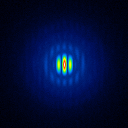 | 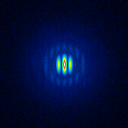 | 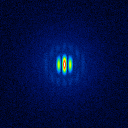 |
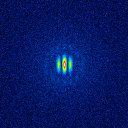 | 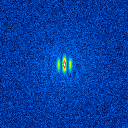 | 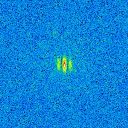 |
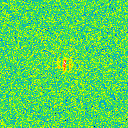 | 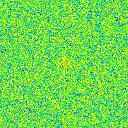 | 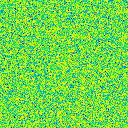 |
The basis of this simulation is an image of NGC4151 with an overlayed dust torus (see figure 1). The simulated raw images are shown in figure 3.
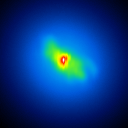 | 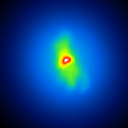 | 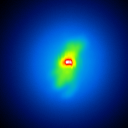 | 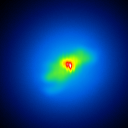 | 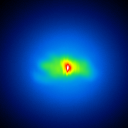 |
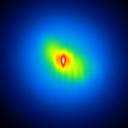 | 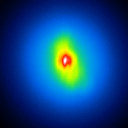 | 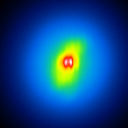 | 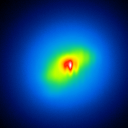 | 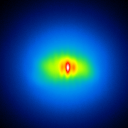 |
A comparison of the reconstructions depending on the calibrator brightness is presented in figure 4 (J-Band) and figure 5 (K-Band).
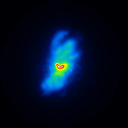 | 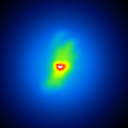 | |
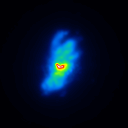 | 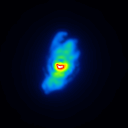 | 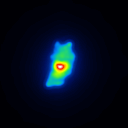 |
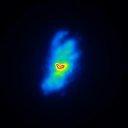 | 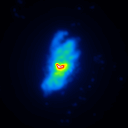 | 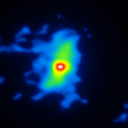 |
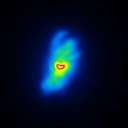 | 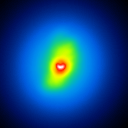 | |
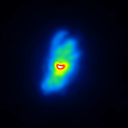 | 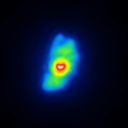 | 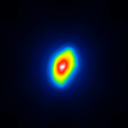 |
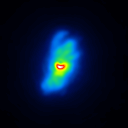 | 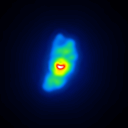 | 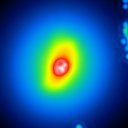 |
In table 2 (J-Band) and table 3 (K-Band) the errors for the AGN depending on the psf star brightness are presented. In figure 6 the image errors depending on the calibrator brightness are shown.
| Testcase | Richardson-Lucy | Building-Block |
|---|---|---|
| Mag (C) | Image Error | Image Error |
| 14.0 | 0.011 (0.011) | 0.004 (0.004) |
| 15.0 | 0.024 (0.024) | 0.005 (0.005) |
| 16.0 | 0.055 (0.052) | 0.006 (0.006) |
| 17.0 | 0.093 (0.081) | 0.010 (0.010) |
| 18.0 | 0.126 (0.111) | 0.025 (0.025) |
| 19.0 | 0.160 (0.144) | 0.072 (0.072) |
| 20.0 | 0.190 (0.179) | 0.153 (0.153) |
| 21.0 | 0.233 (0.226) | 0.241 (0.241) |
| 22.0 | 0.297 (0.286) | 0.461 (0.461) |
| Testcase | Richardson-Lucy | Building-Block |
|---|---|---|
| Mag (C) | Image Error | Image Error |
| 14.0 | 0.033 (0.019) | 0.004 (0.004) |
| 15.0 | 0.056 (0.054) | 0.007 (0.007) |
| 16.0 | 0.117 (0.107) | 0.015 (0.015) |
| 17.0 | 0.173 (0.165) | 0.048 (0.048) |
| 18.0 | 0.211 (0.207) | 0.115 (0.115) |
| 19.0 | 0.246 (0.244) | 0.219 (0.219) |
| 20.0 | 0.302 (0.290) | 0.305 (0.305) |
| 21.0 | 0.361 (0.349) | 0.652 (0.652) |
| 22.0 | 0.519 (0.502) | 0.825 (0.825) |
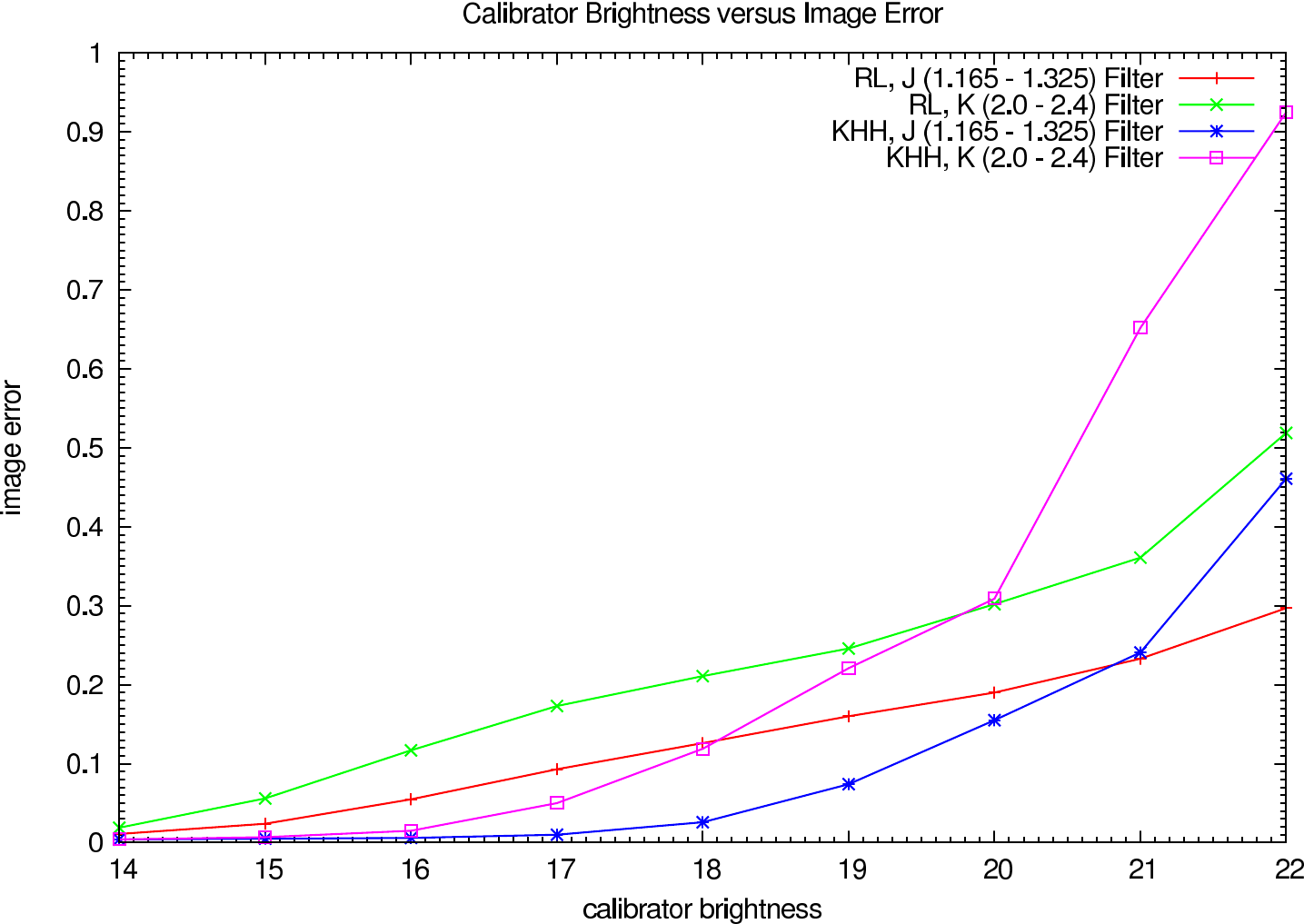 |
In figure 7 the image error describing the difference between the reconstruction and the reference image is shown for each iteration (in steps of 100 iterations). The effect of the calibratior brightness on the reconstruction error and the optimal iteration number is clearly visible.
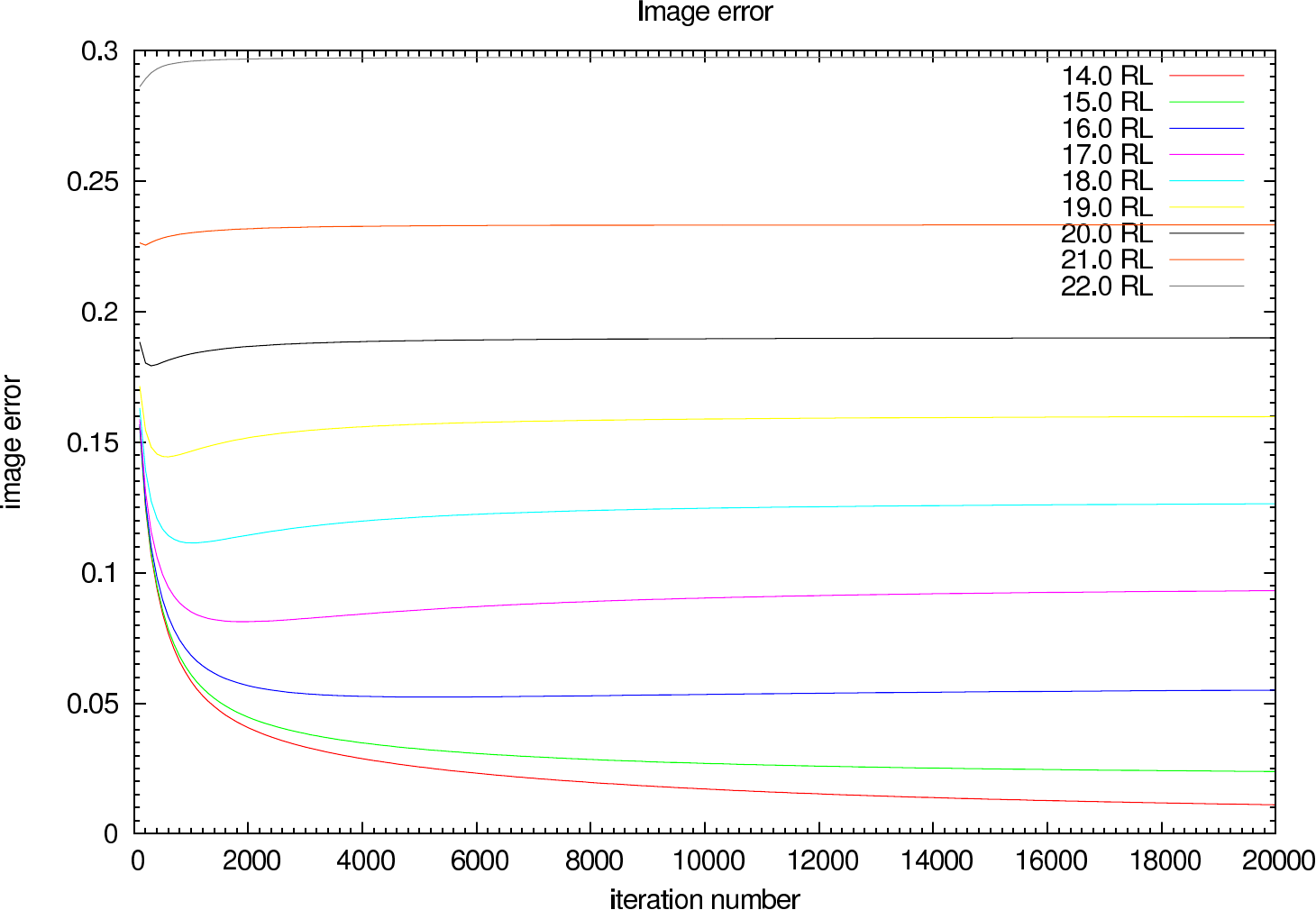 | 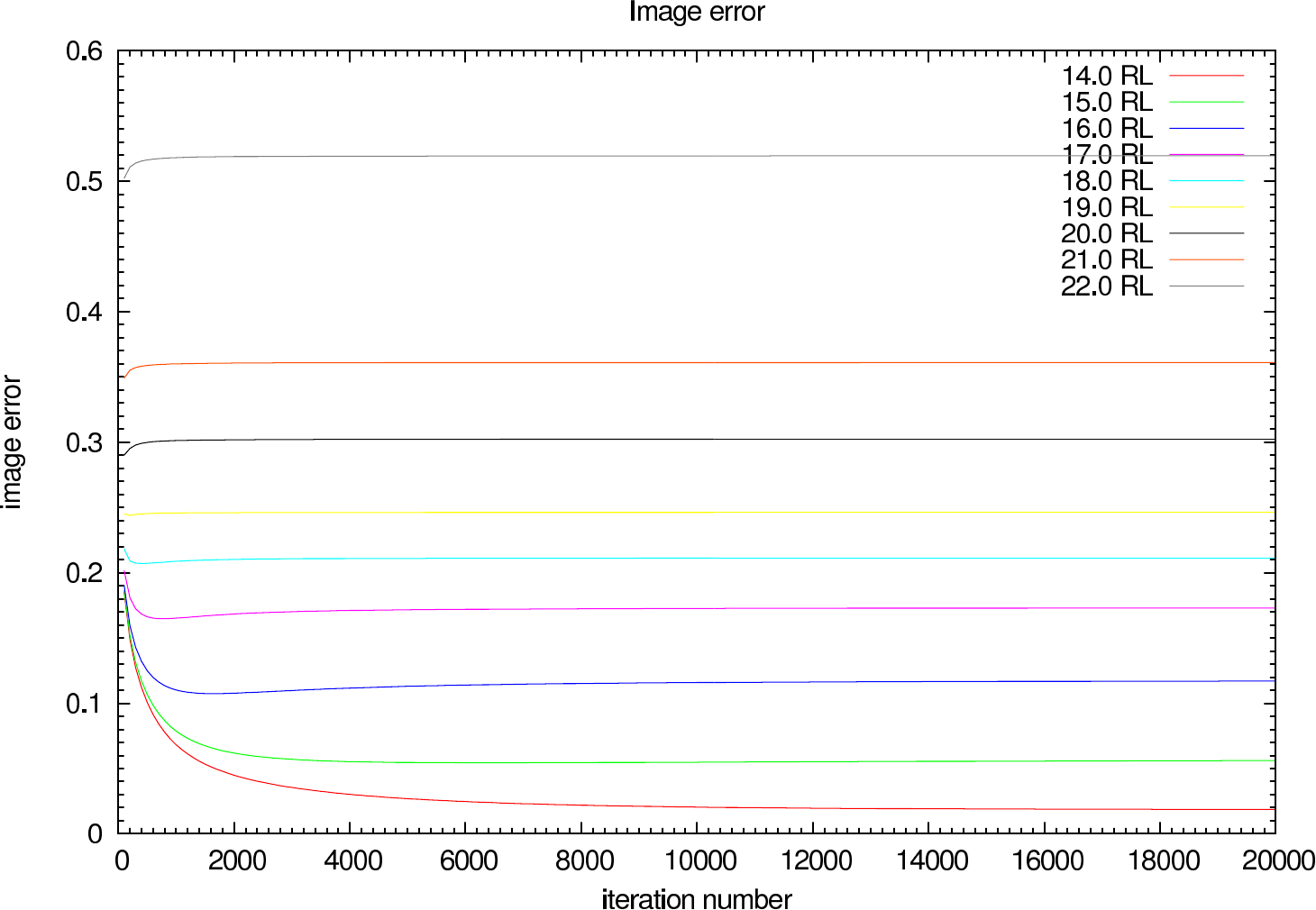 |
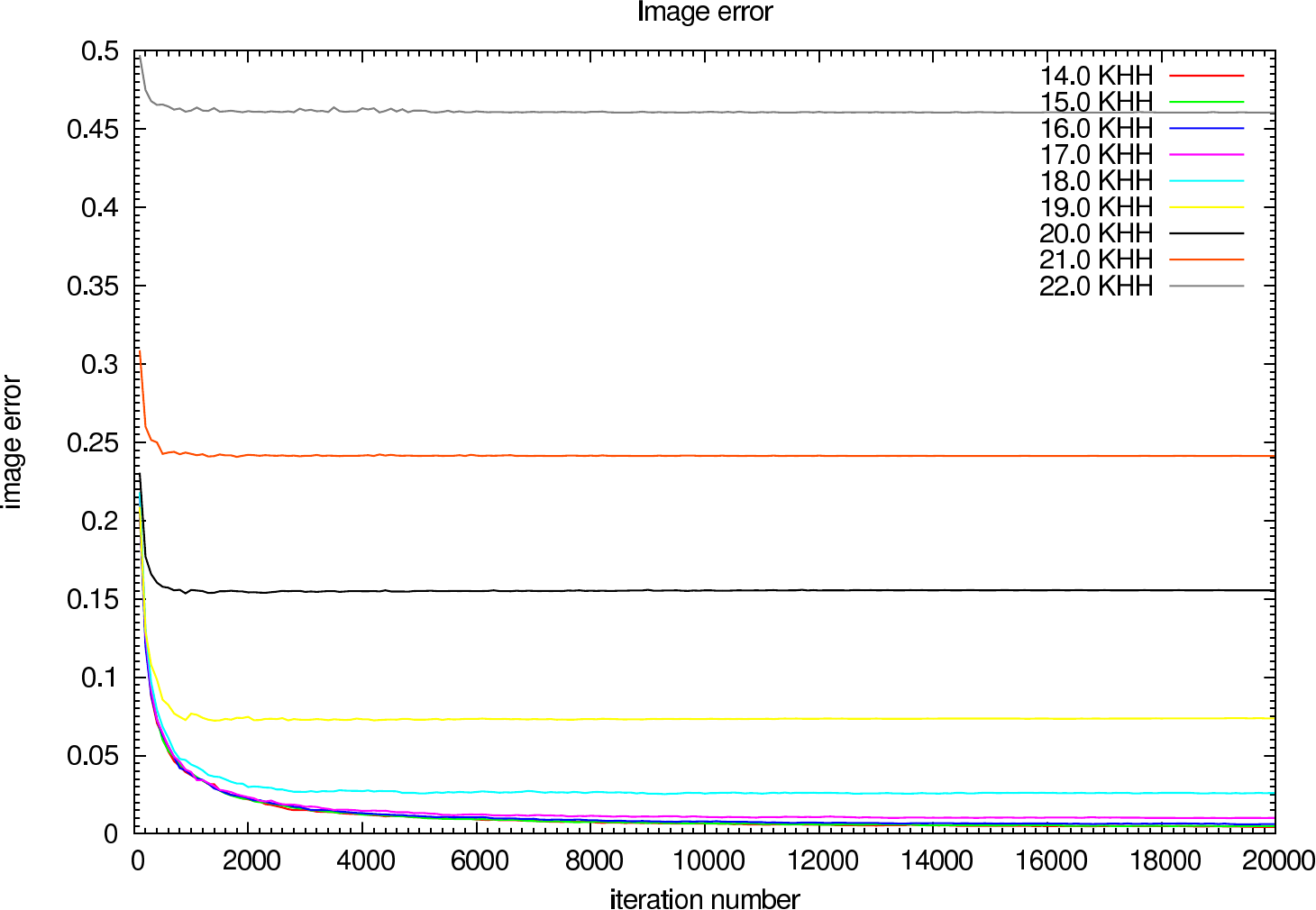 | 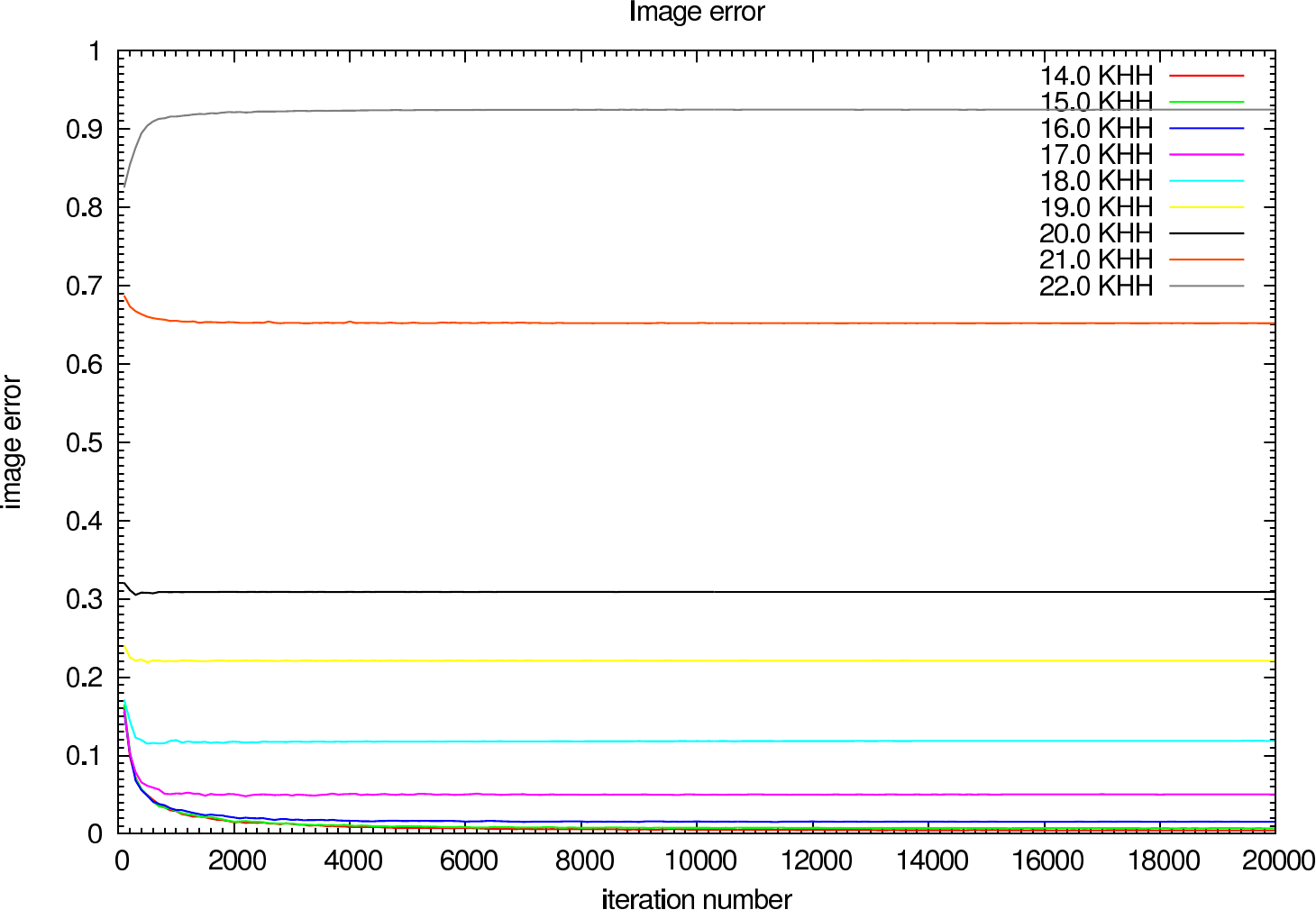 |
In figure 8 (J-Band) and figure 9 (K-Band) a horizontal cut slightly above the intensity maximum of the reconstructions of NGC4151 compared with the ideal reference image is shown.
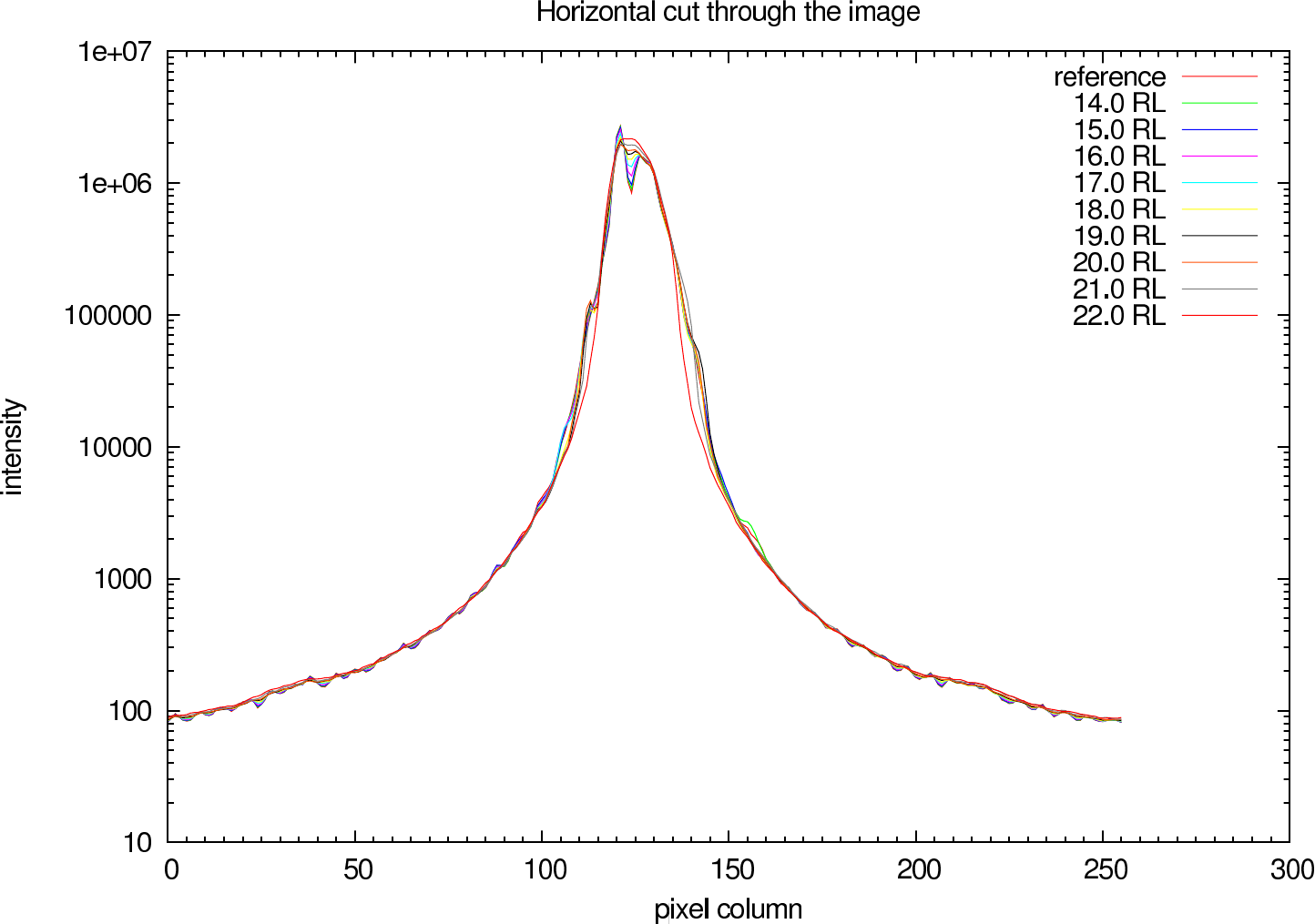 | 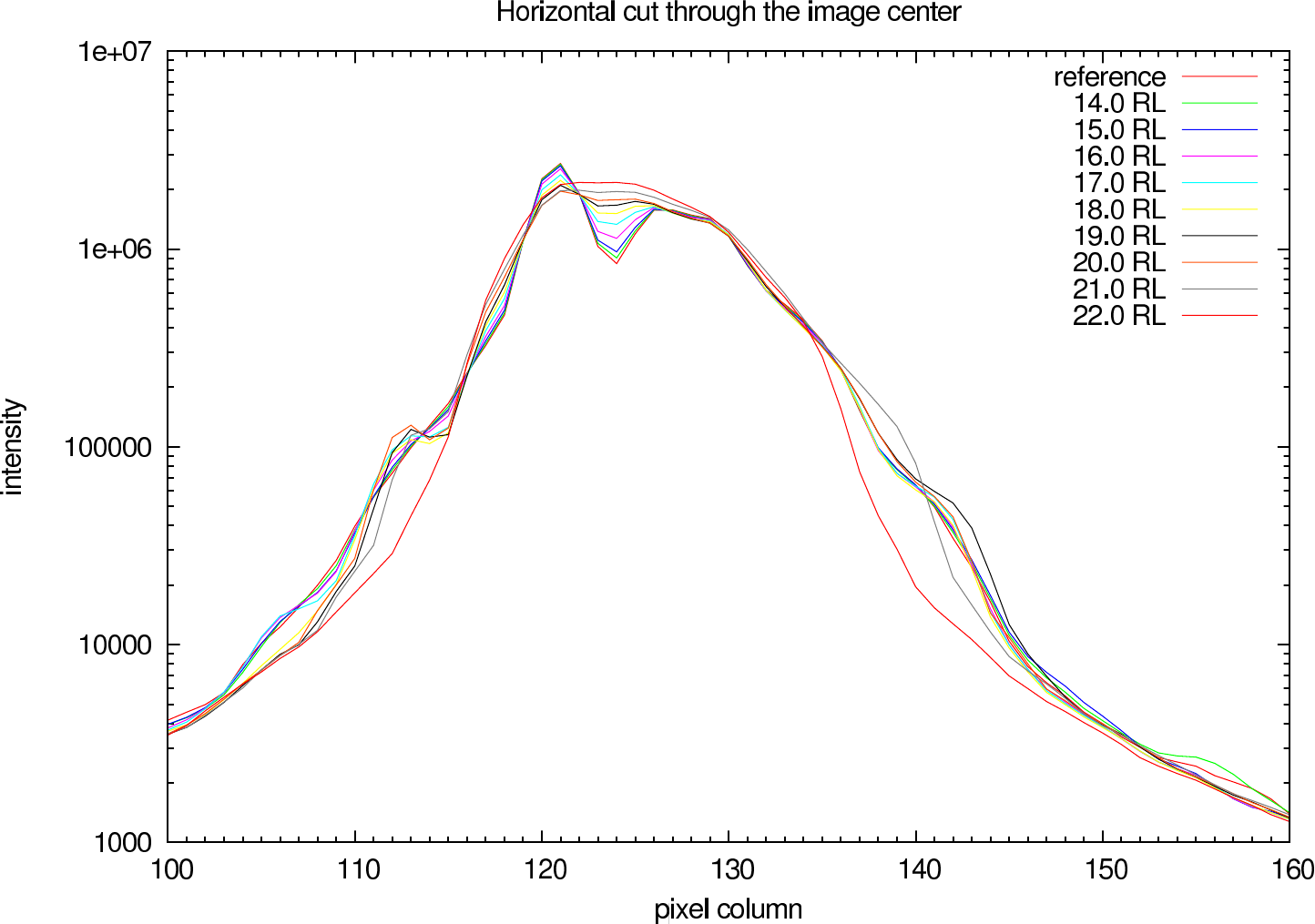 |
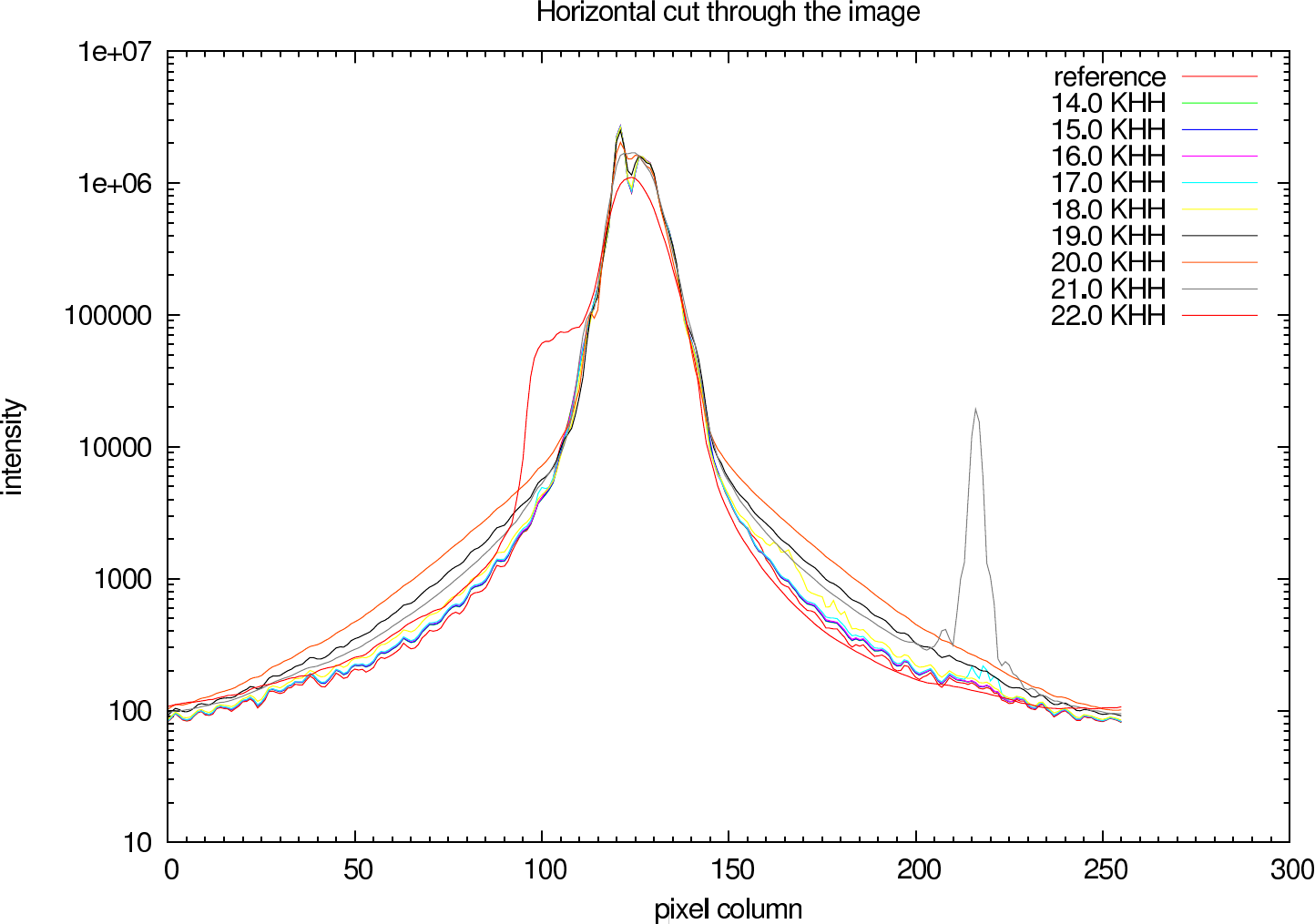 | 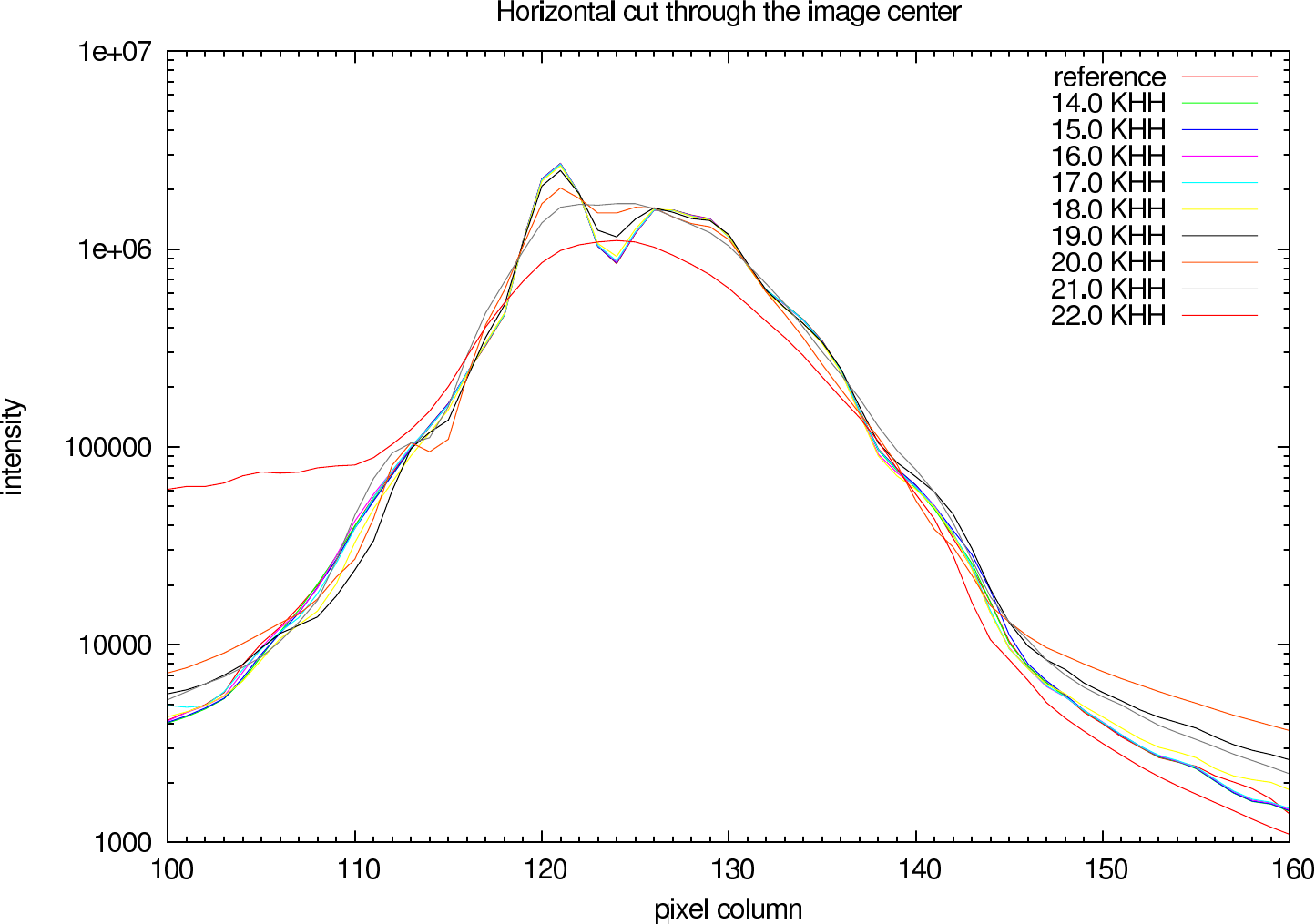 |
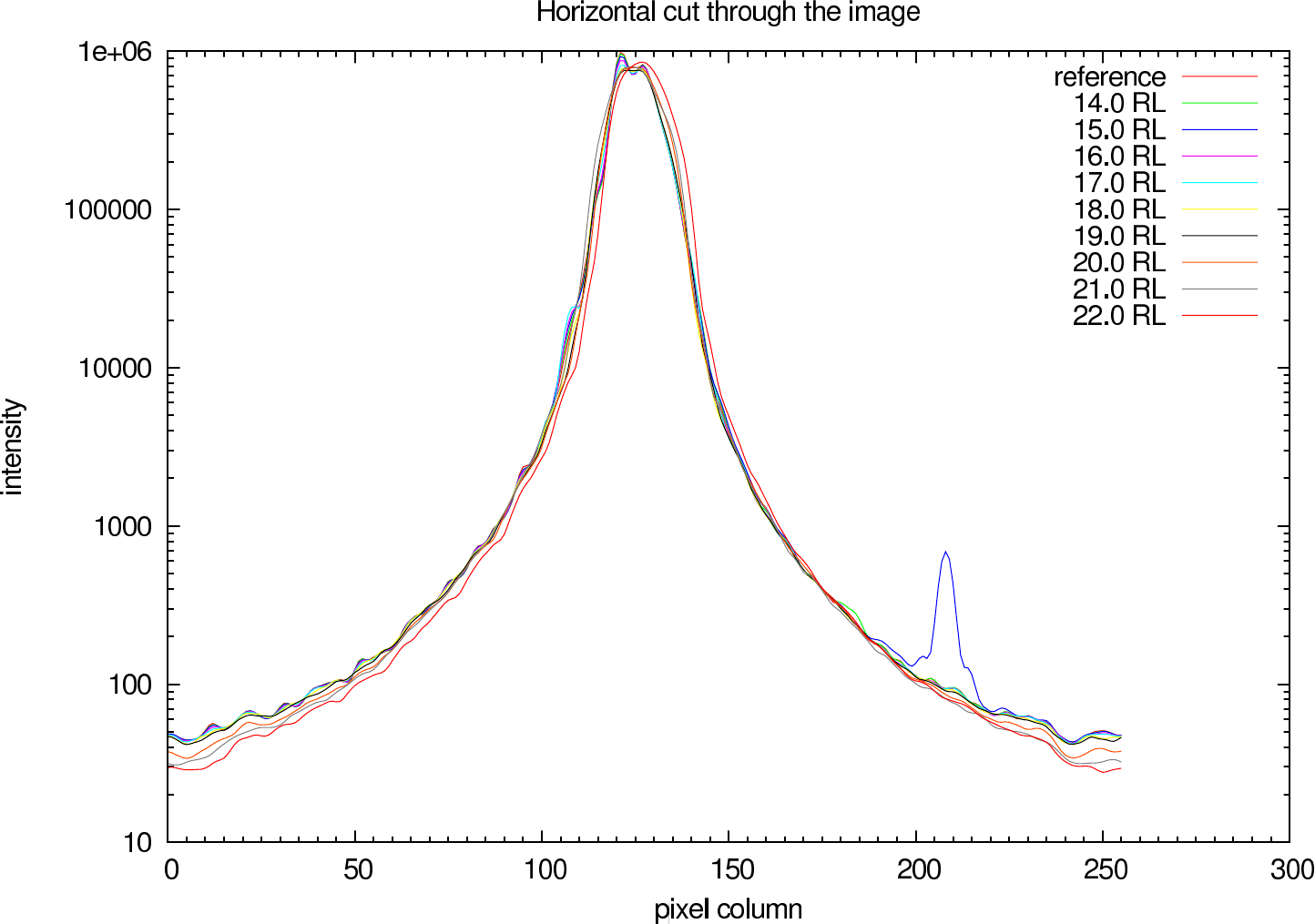 | 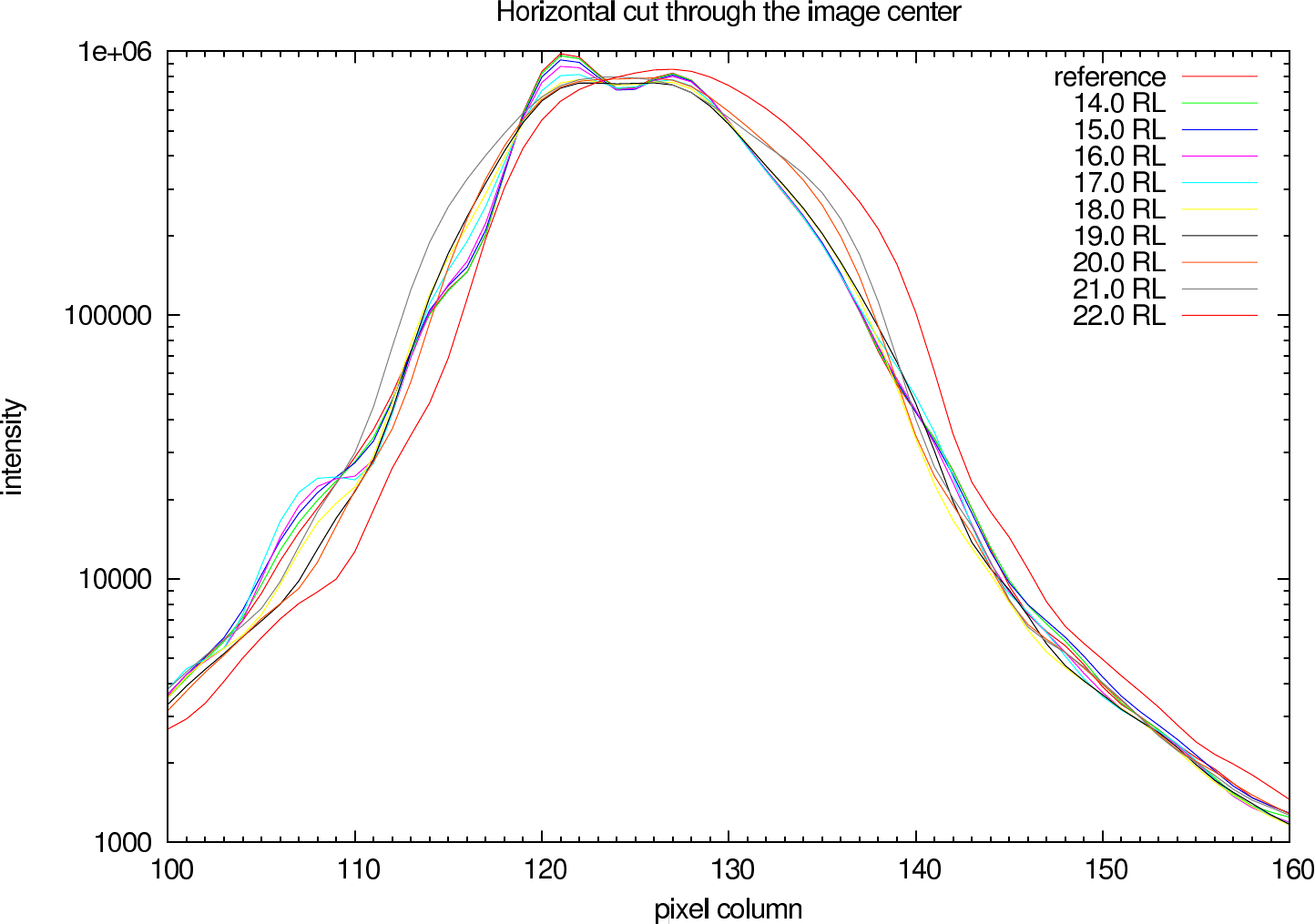 |
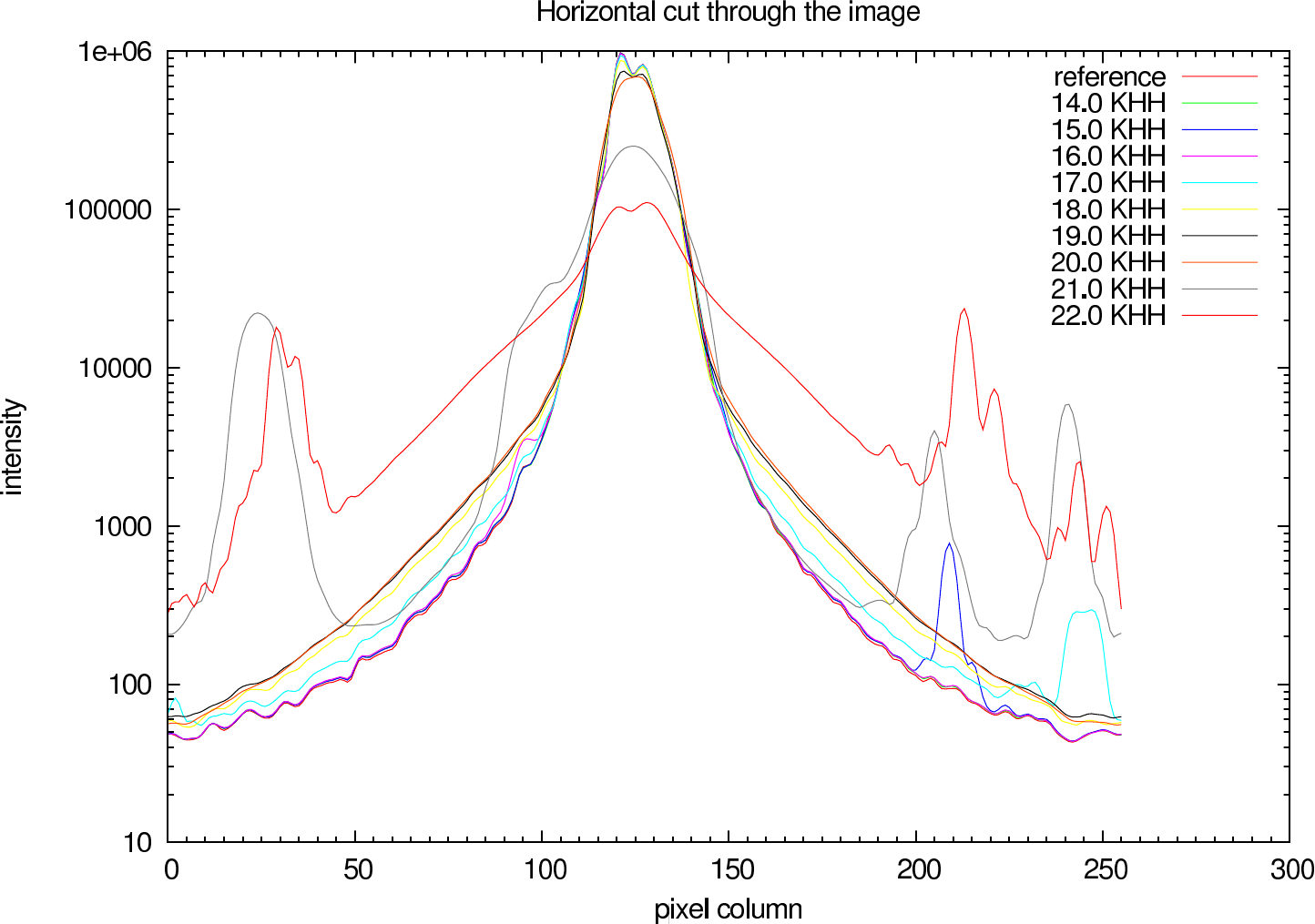 | 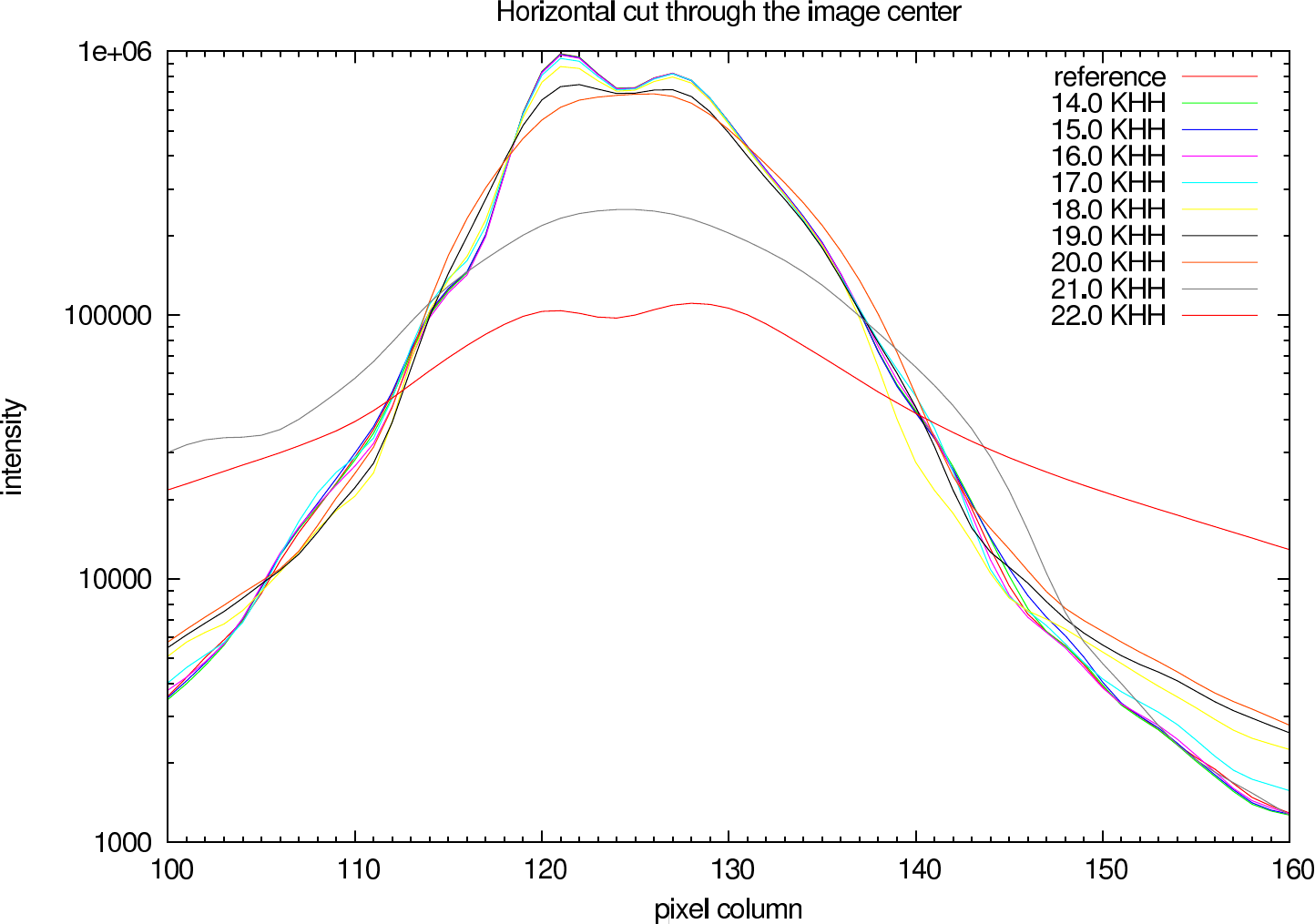 |
The basis of this simulation is a small star cluster (see figure 2). The simulated raw images are shown in figure 10.
 |  |  |  |  |
 |  |  |  |  |
A comparison of the reconstructions depending on the calibrator brightness is presented in figure 4 (J-Band) and figure 5 (K-Band).
 |  | |
 |  |  |
 |  |  |
 |  | |
 |  |  |
 |  |  |
In table 4 (J-Band) and table 5 (K-Band) the errors for the star cluster depending on the psf star brightness are presented. The image errors are also summarized in figure 13 and the photometric errors in figure 14.
| Testcase | Richardson-Lucy | Building-Block | ||
|---|---|---|---|---|
| Mag (C) | Image Error | Magnitude Error | Image Error | Magnitude Error |
| 14.0 | 0.011 (0.011) | 0.01, 0.01, -0.01, 0.16, 0.03 | 0.012 (0.012) | 0.01, 0.00, 0.09, 0.29, 0.41 |
| 15.0 | 0.010 (0.010) | 0.01, 0.00, -0.00, 0.17, 0.04 | 0.012 (0.012) | 0.01, 0.00, 0.09, 0.30, 0.41 |
| 16.0 | 0.009 (0.009) | 0.00, -0.00, 0.00, 0.20, 0.10 | 0.012 (0.012) | 0.01, 0.00, 0.08, 0.28, 0.36 |
| 17.0 | 0.015 (0.015) | 0.01, -0.02, 0.10, 0.38, 0.49 | 0.013 (0.013) | 0.01, 0.01, 0.07, 0.22, 0.24 |
| 18.0 | 0.044 (0.043) | 0.02, -0.04, 0.38, 1.73, 2.69 | 0.019 (0.019) | 0.01, 0.01, 0.01, 0.23, 0.15 |
| 19.0 | 0.096 (0.095) | 0.10, -0.08, 1.86, 4.81, 2.67 | 0.078 (0.078) | 0.01, 0.01, 0.13, 0.54, 0.52 |
| 20.0 | 0.177 (0.176) | 0.35, -0.08, 1.84, 4.83, 2.64 | 0.319 (0.308) | 0.07, 0.05, 0.38, 0.46, 0.41 |
| 21.0 | 0.308 (0.308) | 1.16, -0.10, 1.81, 4.88, 2.60 | 0.626 (0.621) | 0.24, 0.14, 0.82, 4.65, 2.66 |
| 22.0 | 0.464 (0.463) | 8.28, 0.07, 1.95, 4.99, 2.57 | 0.826 (0.826) | 0.76, 0.88, -0.34, 4.65, 2.40 |
| Testcase | Richardson-Lucy | Building-Block | ||
|---|---|---|---|---|
| Mag (C) | Image Error | Magnitude Error | Image Error | Magnitude Error |
| 14.0 | 0.050 (0.050) | 0.05, 0.01, 0.18, 0.38, 0.63 | 0.038 (0.038) | 0.06, 0.01, 0.23, 0.44, 0.76 |
| 15.0 | 0.048 (0.048) | 0.04, 0.00, 0.17, 0.41, 0.79 | 0.039 (0.039) | 0.06, 0.02, 0.21, 0.46, 0.78 |
| 16.0 | 0.050 (0.050) | 0.04, -0.02, 0.33, 1.04, 2.08 | 0.038 (0.038) | 0.06, 0.01, 0.23, 0.51, 0.93 |
| 17.0 | 0.076 (0.076) | 0.09, -0.06, 1.49, 4.03, 2.05 | 0.057 (0.057) | 0.09, 0.03, 0.15, 0.56, 1.24 |
| 18.0 | 0.143 (0.143) | 0.46, -0.08, 1.47, 4.04, 2.01 | 0.160 (0.158) | 0.15, 0.07, 0.66, 0.80, 1.72 |
| 19.0 | 0.275 (0.275) | 2.17, -0.10, 1.40, 4.08, 1.96 | 0.459 (0.450) | 0.42, 0.43, 0.07, 0.95, 2.04 |
| 20.0 | 0.358 (0.358) | 7.47, 0.13, 1.55, 4.15, 1.92 | 0.701 (0.700) | 1.16, 0.89, 0.68, 3.94, 2.02 |
| 21.0 | 0.575 (0.575) | 7.20, 0.50, 1.71, 4.25, 1.90 | 0.905 (0.905) | 2.47, 2.21, -0.52, 2.81, 1.42 |
| 22.0 | 0.688 (0.687) | 7.22, 1.42, 1.72, 4.30, 1.87 | 0.986 (0.945) | 5.38, 4.13, 1.10, 4.58, 0.83 |
 |
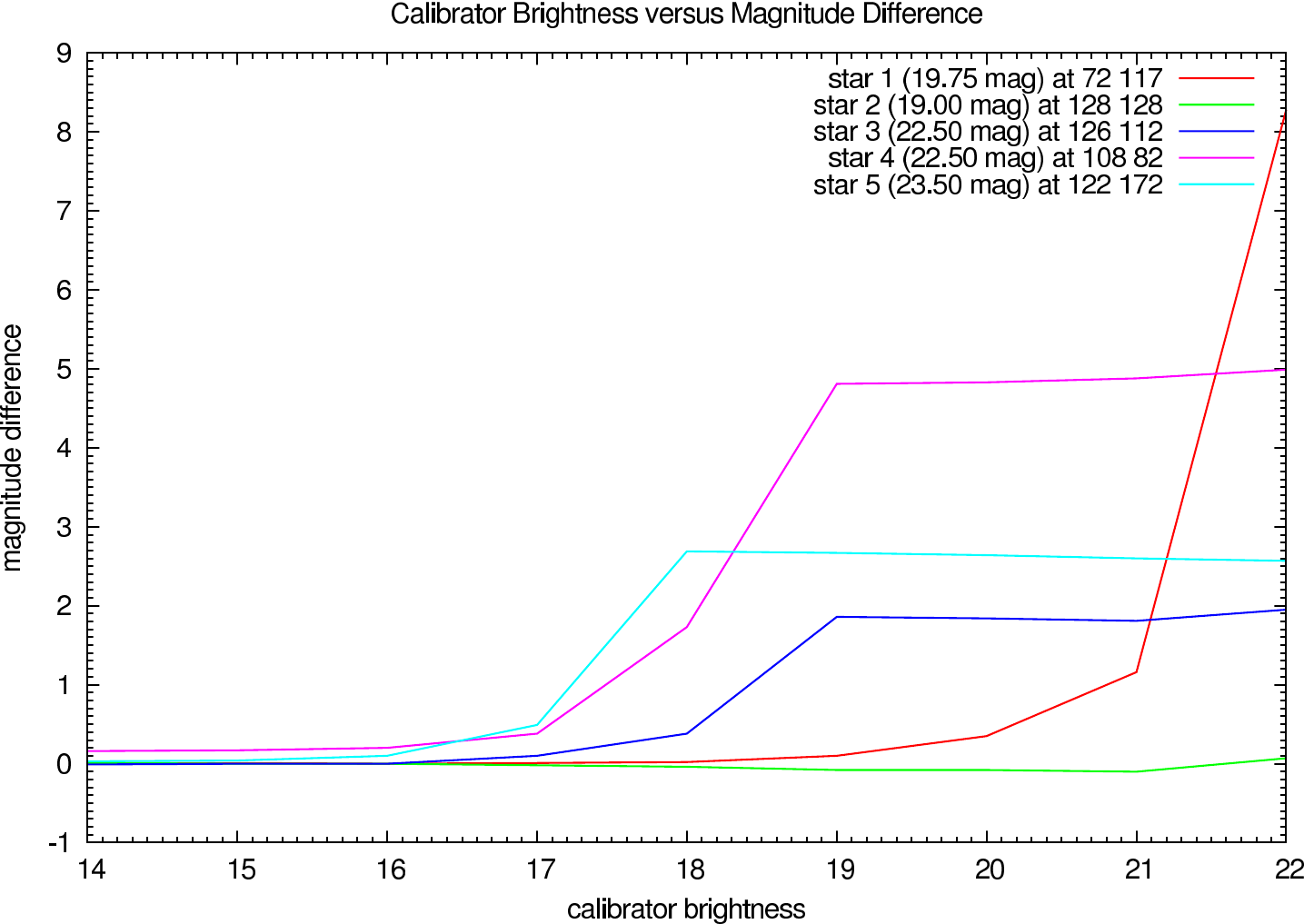 | 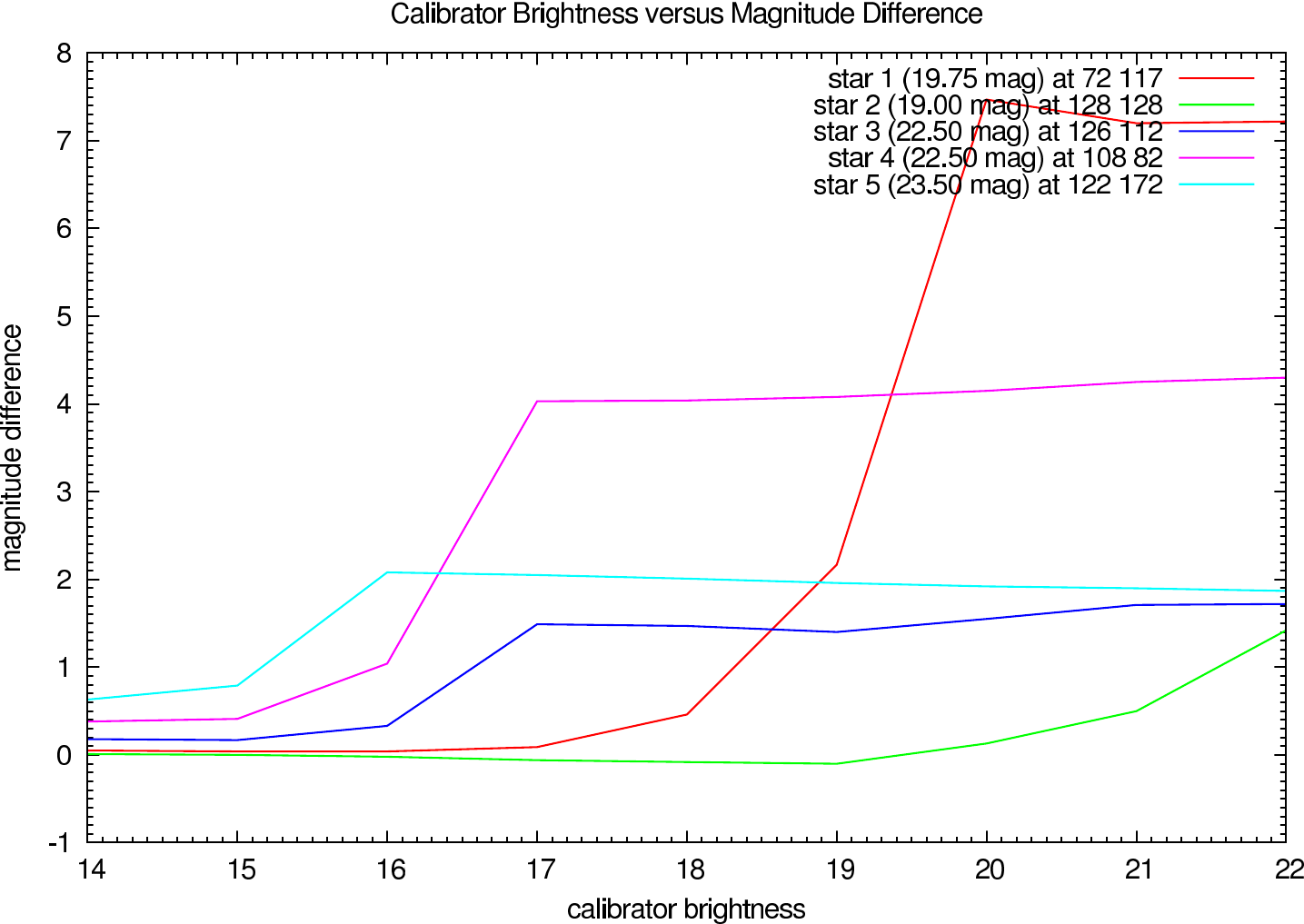 |
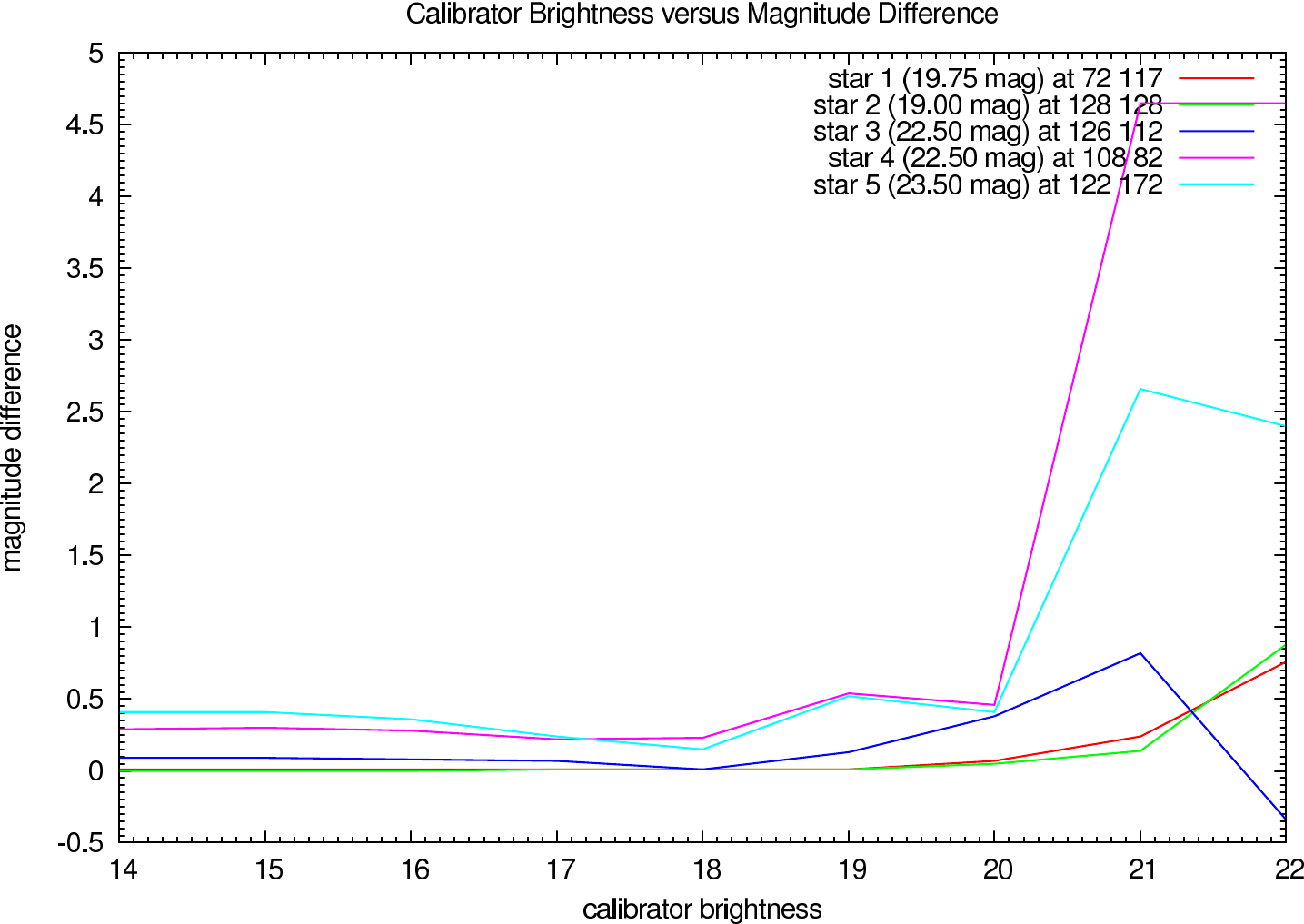 | 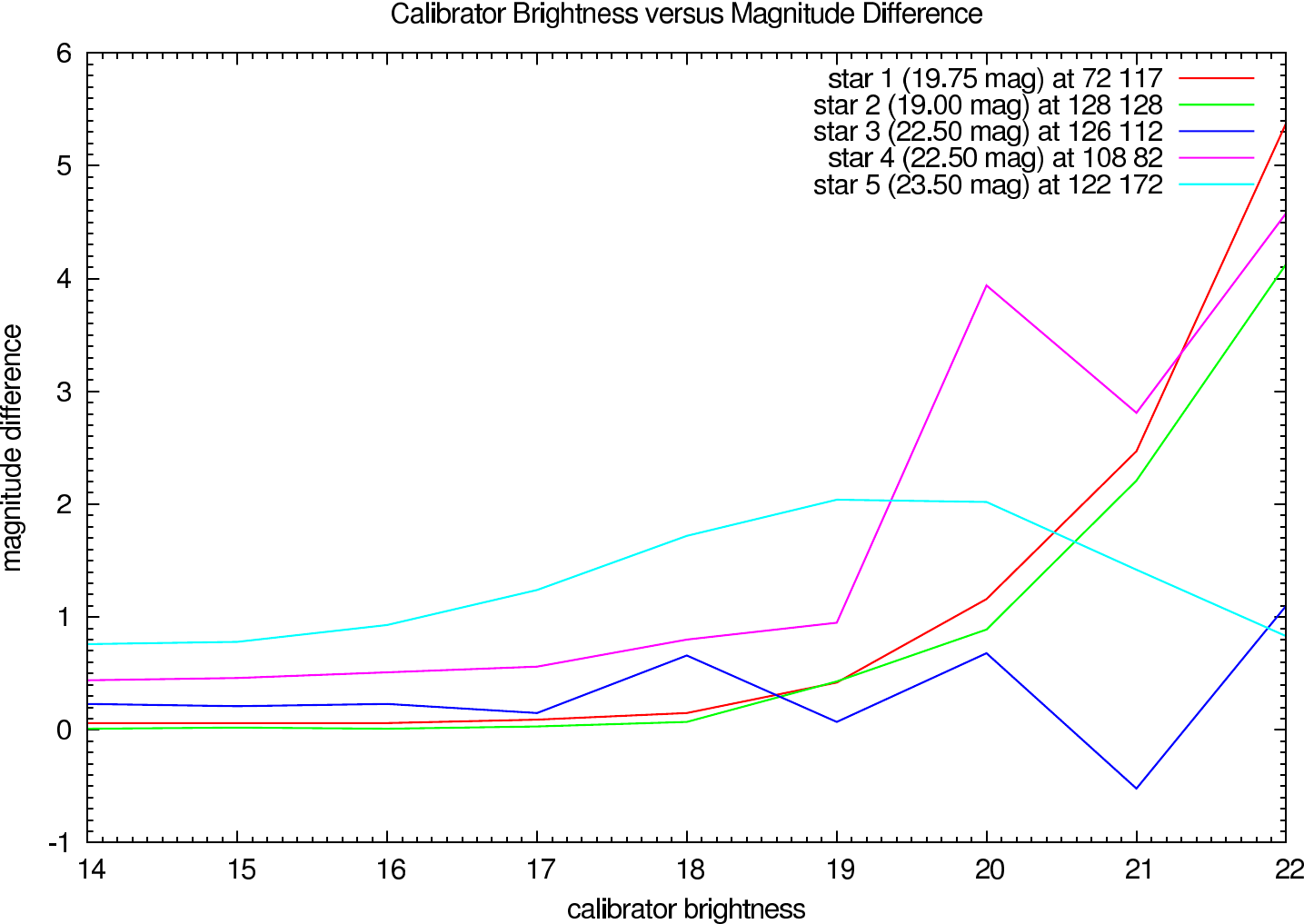 |
In figure 15 the image error describing the difference between the reconstruction and the reference image is shown for each iteration (in steps of 100 iterations). The effect of the calibratior brightness on the reconstruction error and the optimal iteration number is clearly visible.
 |  |
 |  |
In figure 16, figure 17, and figure 18 the image and photometric errors depending on the calibrator brightness and the iteration number is shown. The overall shape is the same, but the optimum number of iterations is difficult to select, because not all photometric errors have their minimum at the same iteration number.
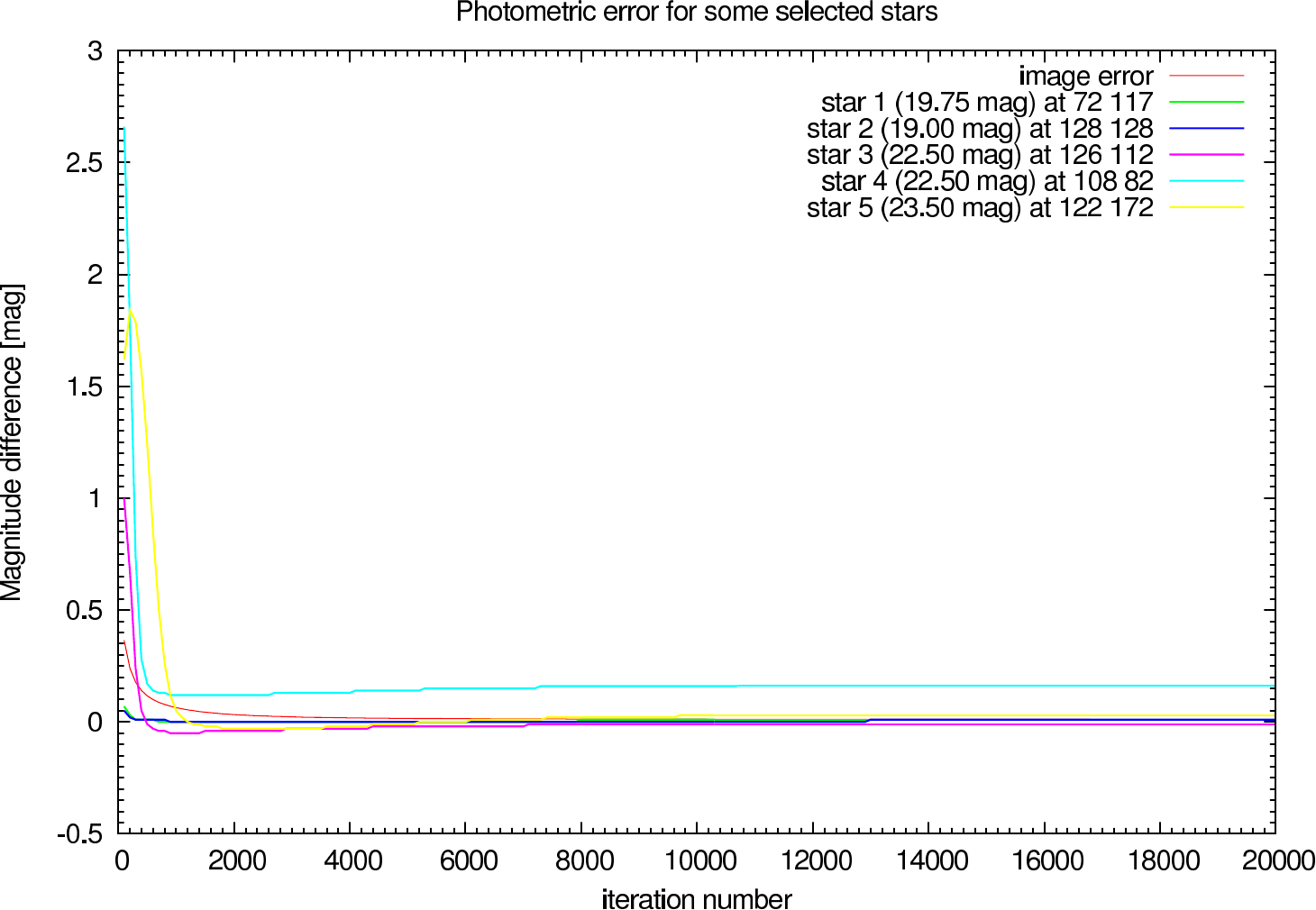 | 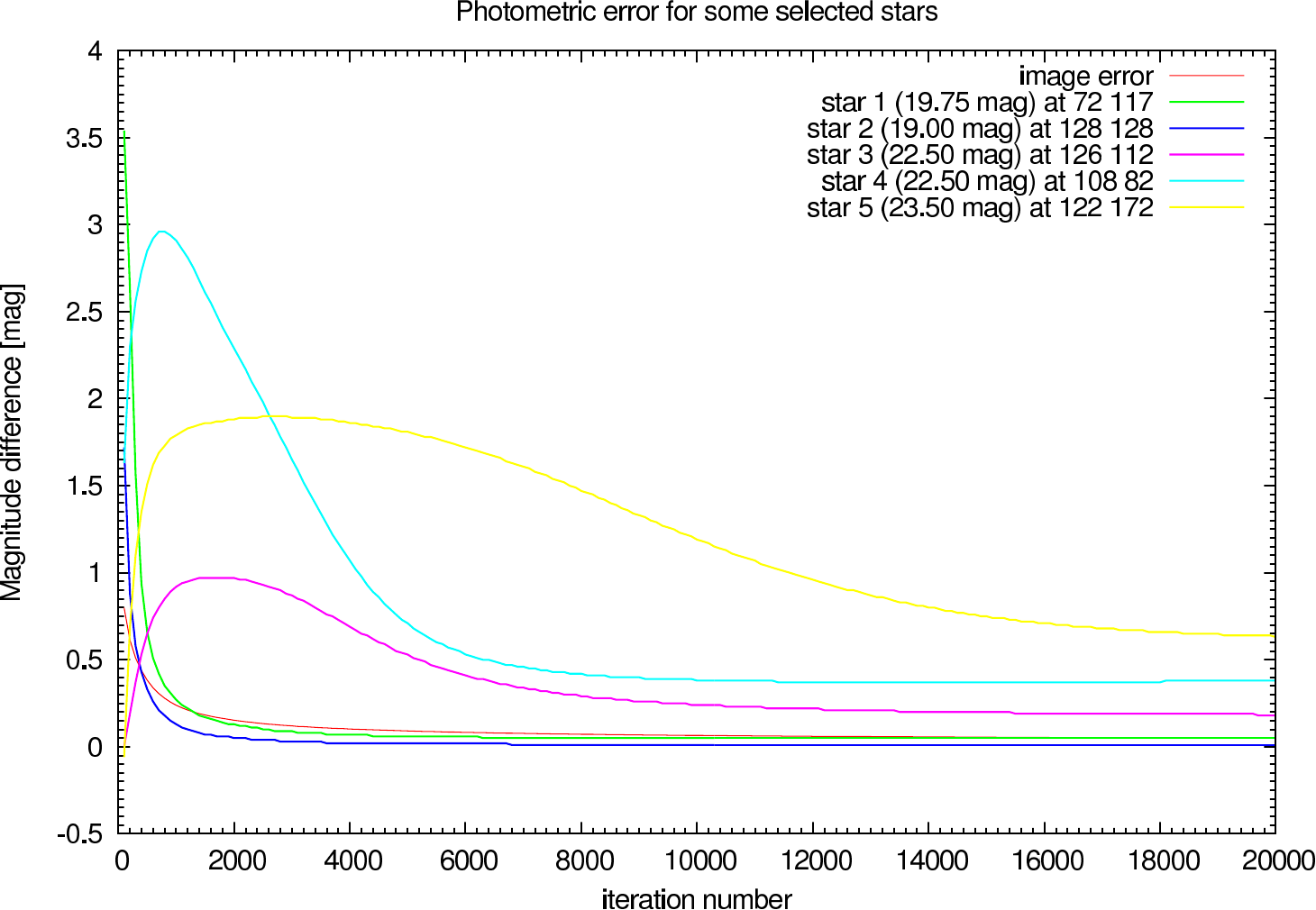 |
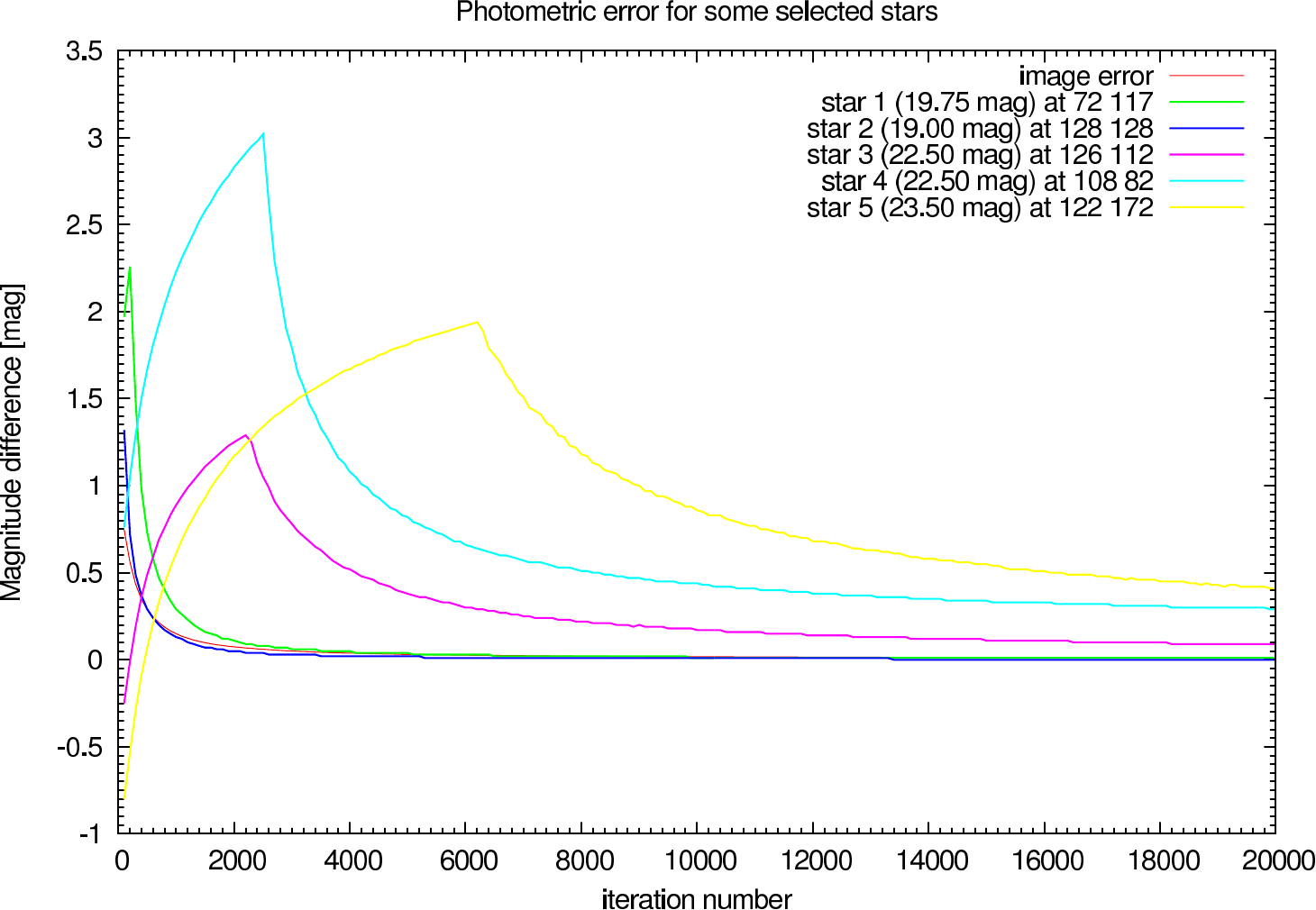 | 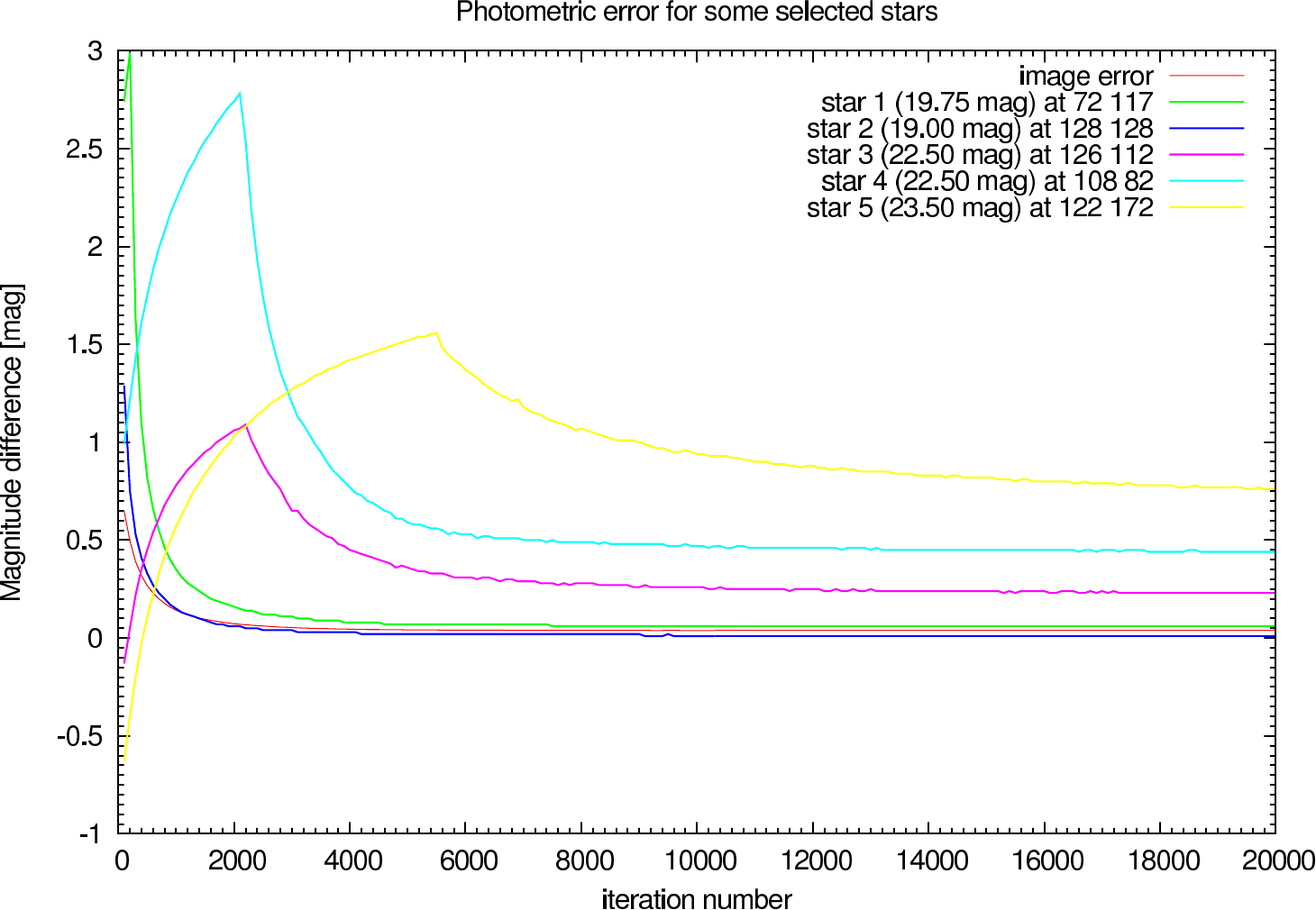 |
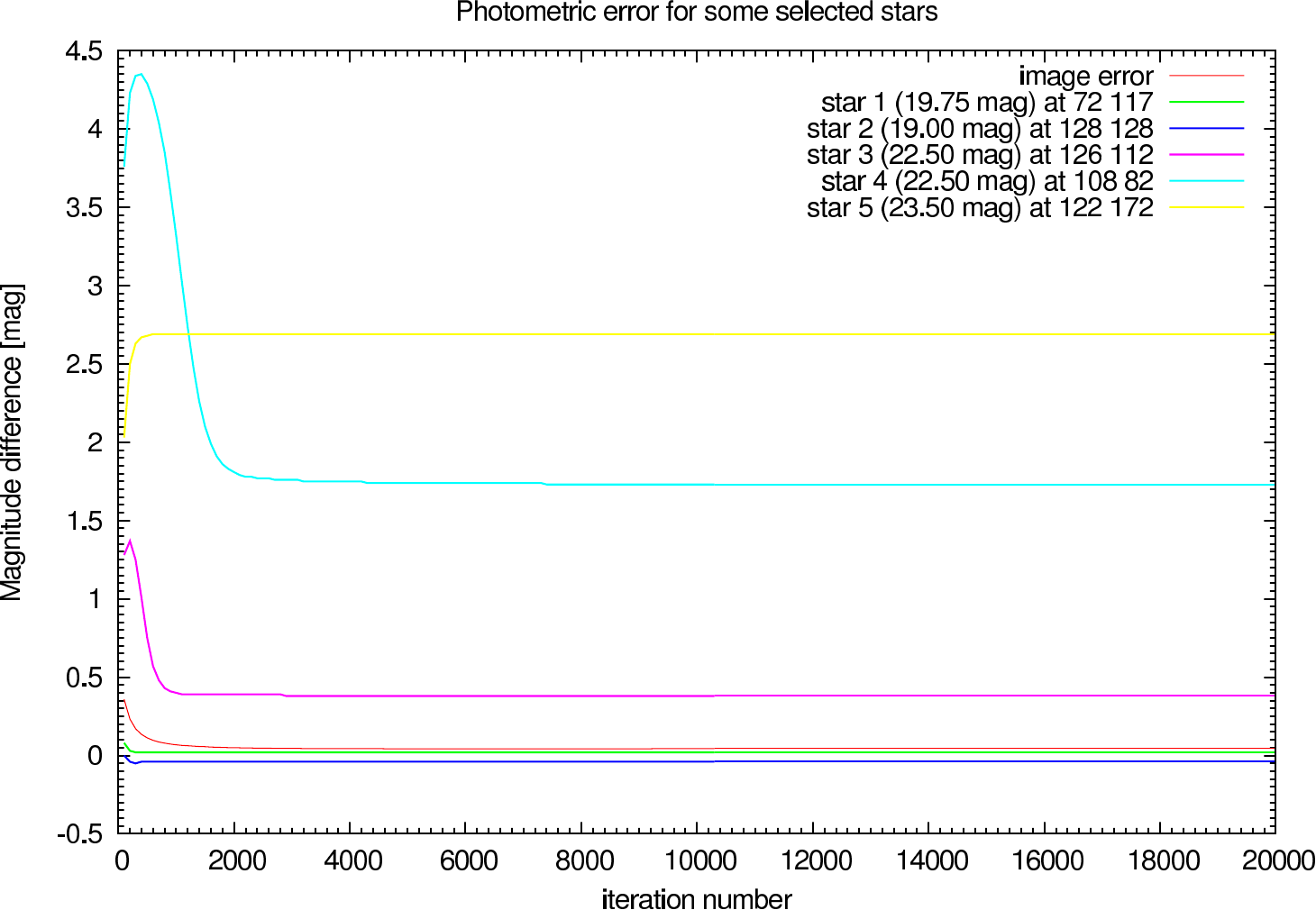 | 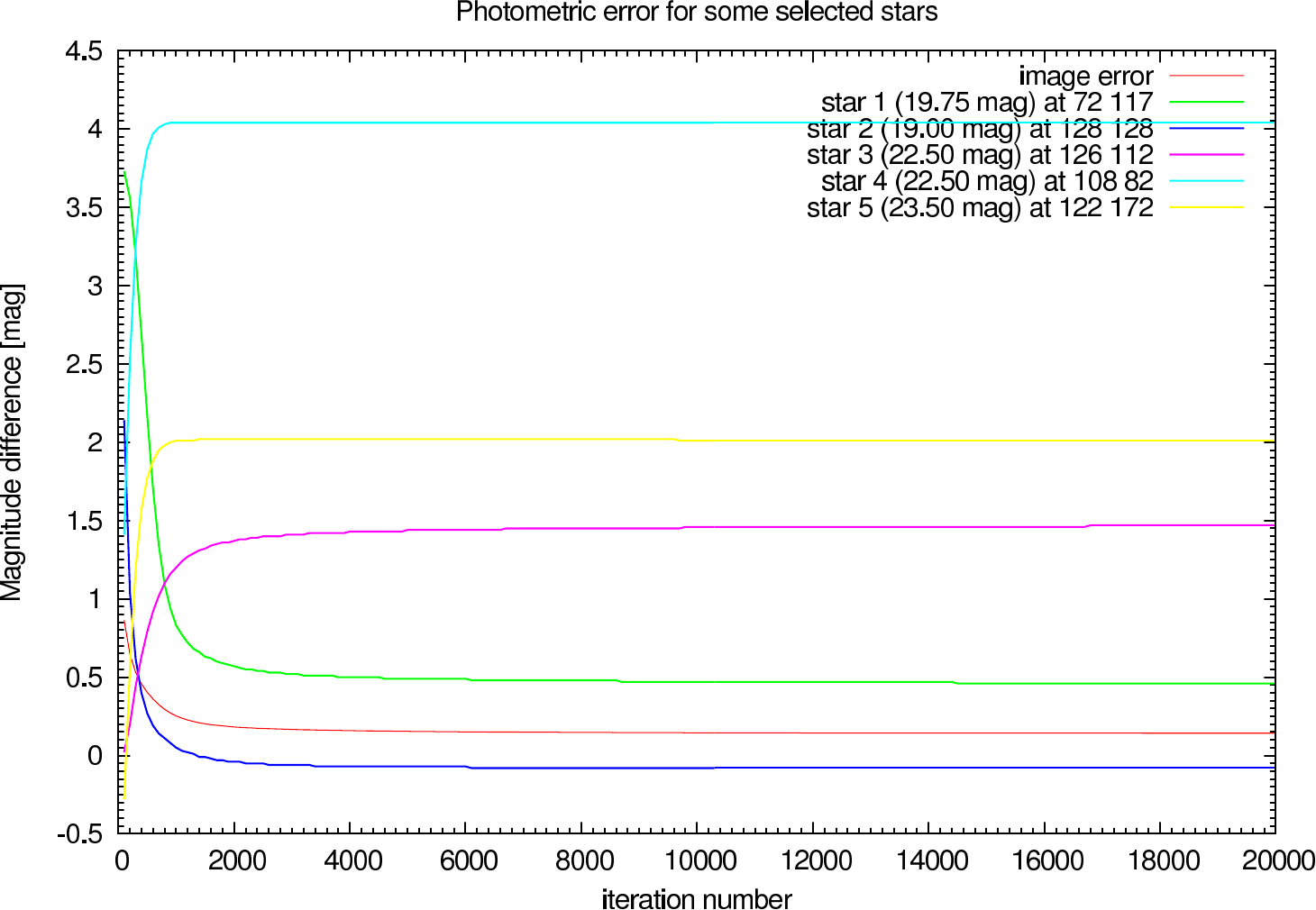 |
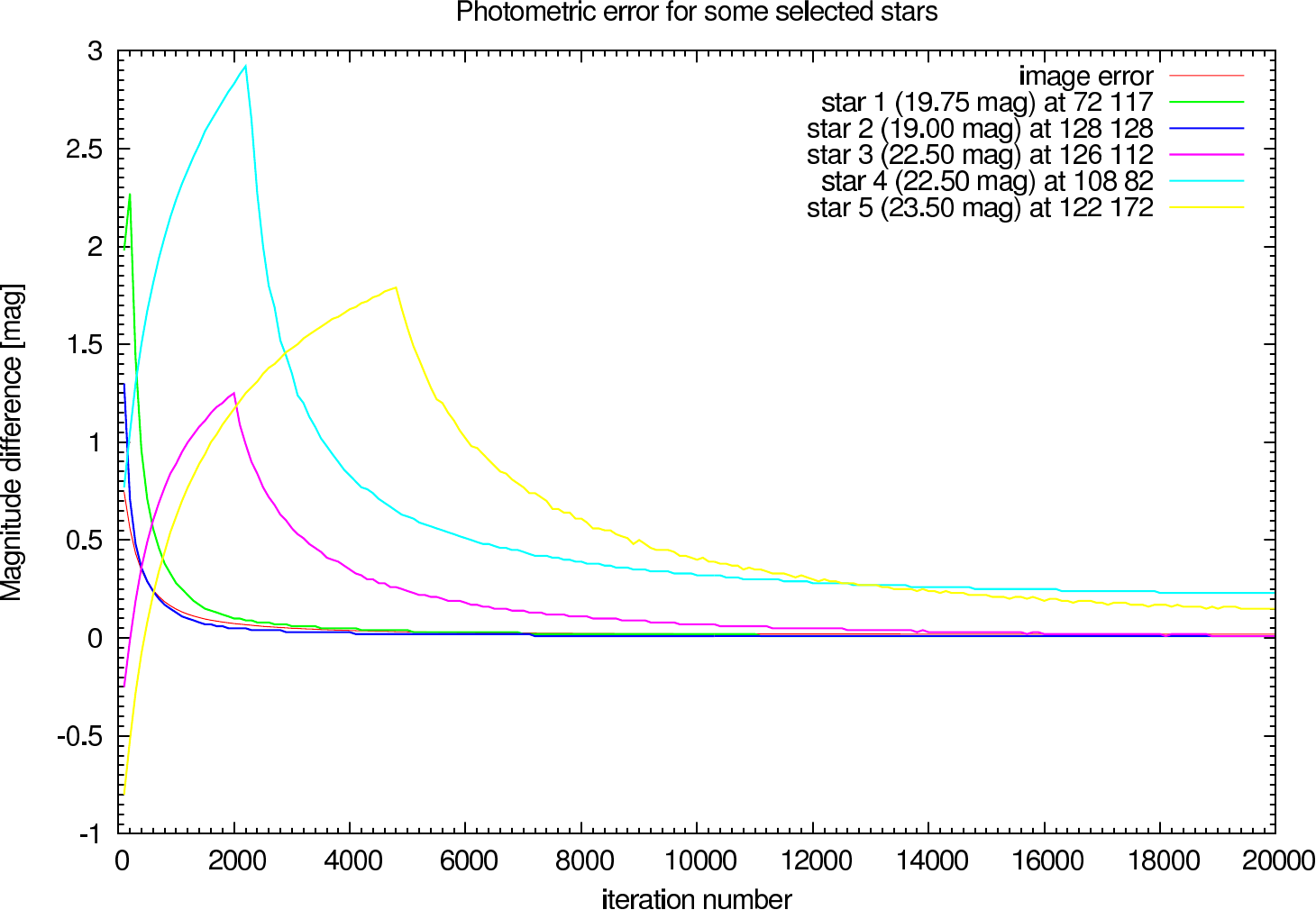 | 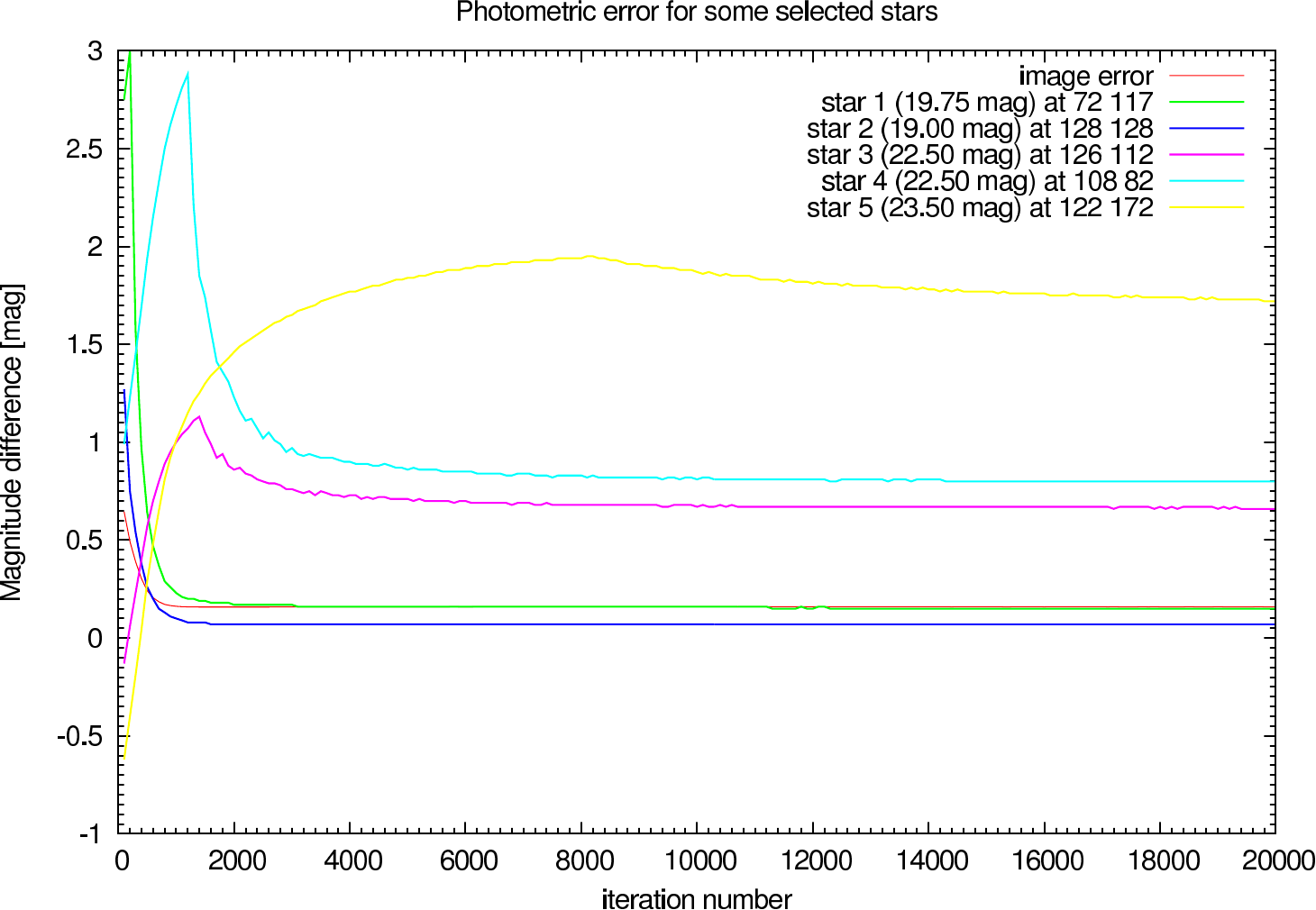 |
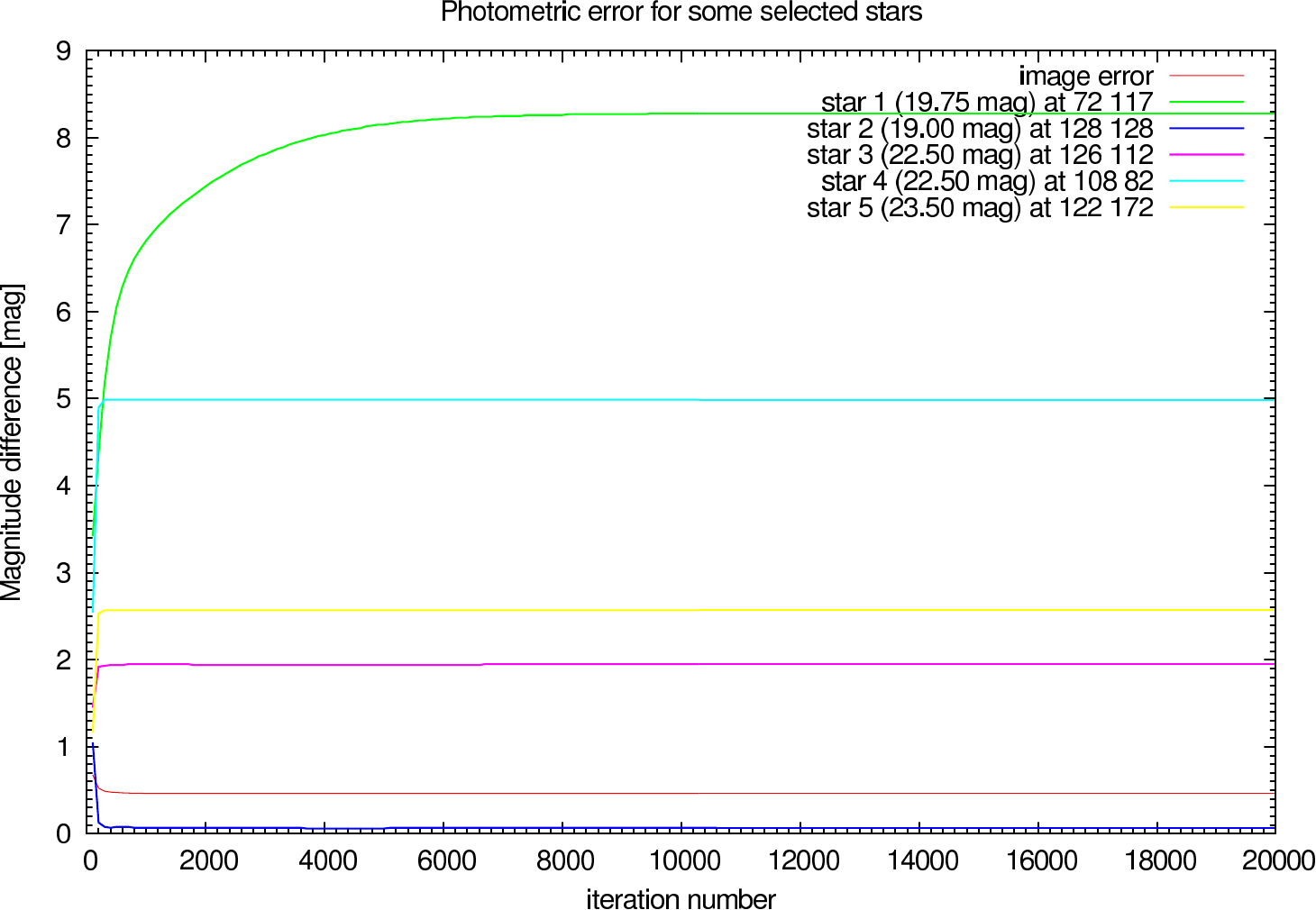 | 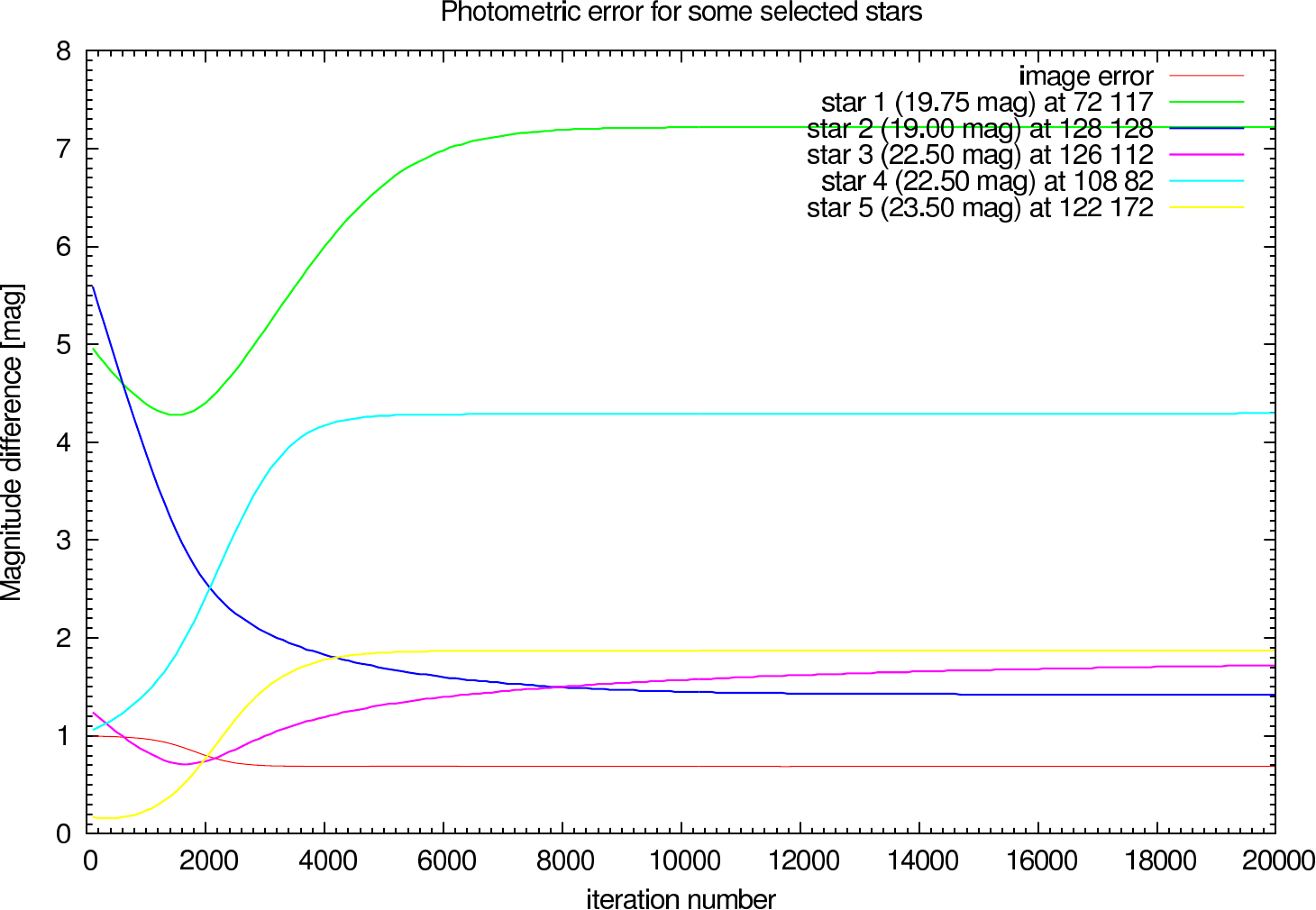 |
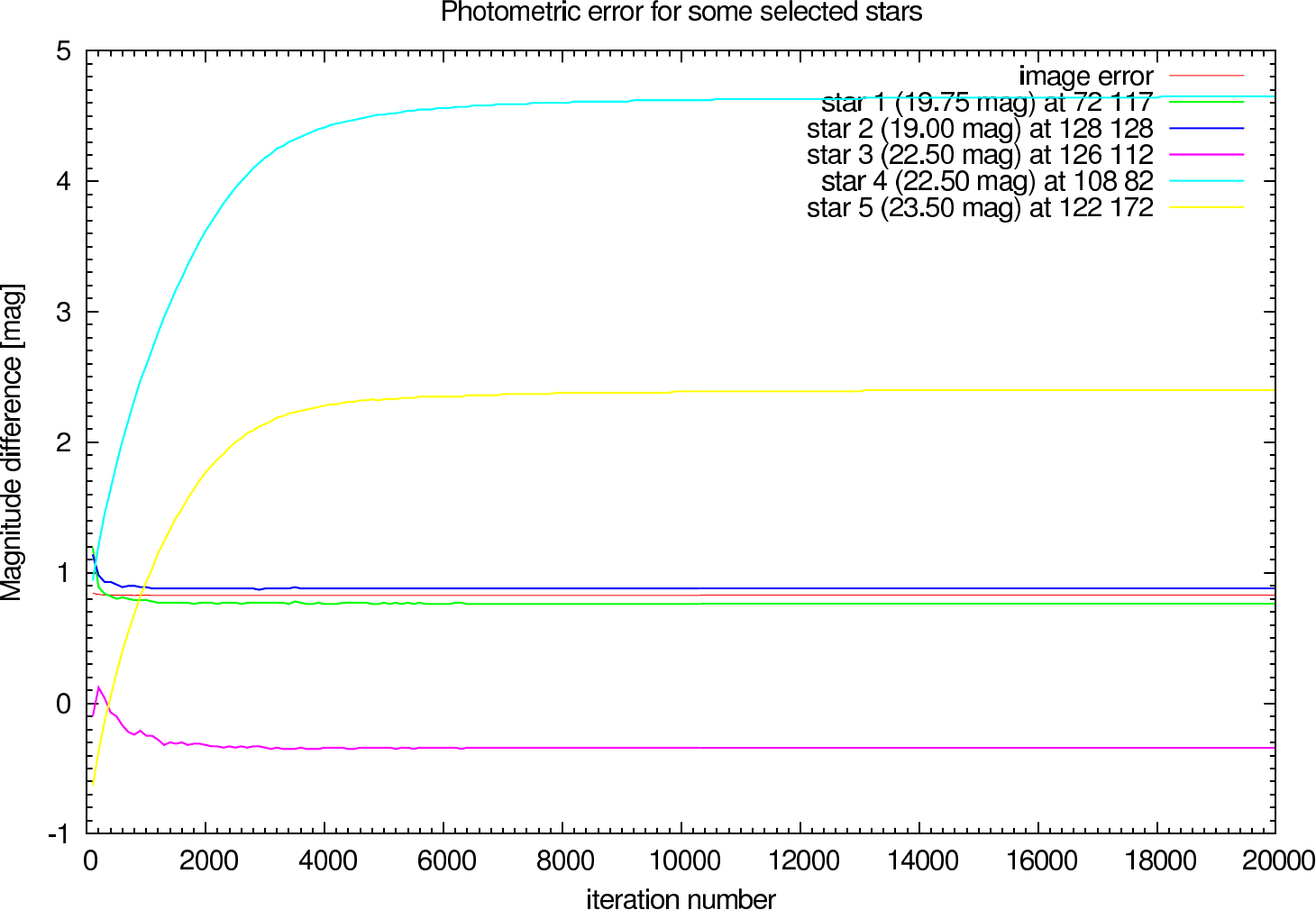 | 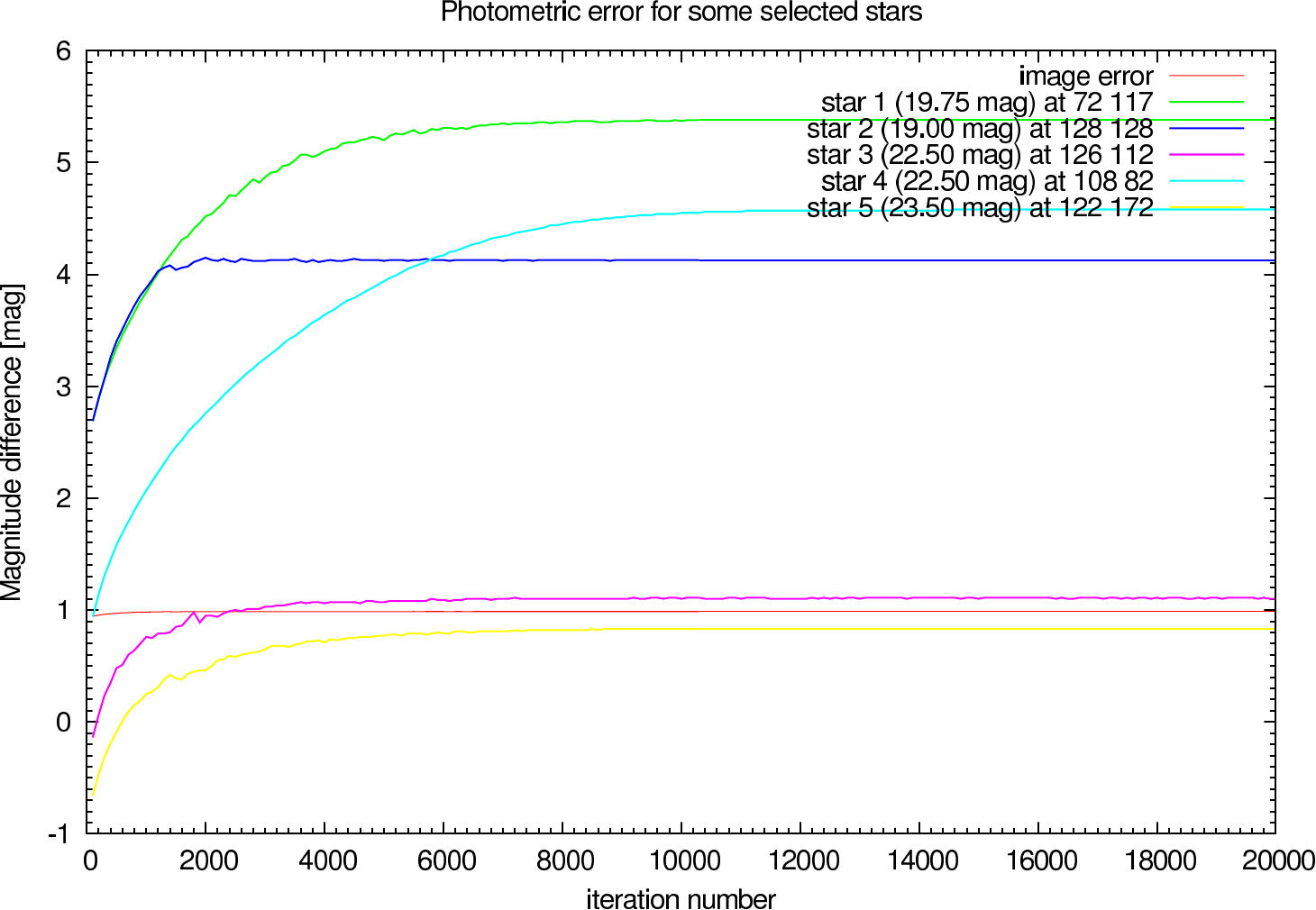 |